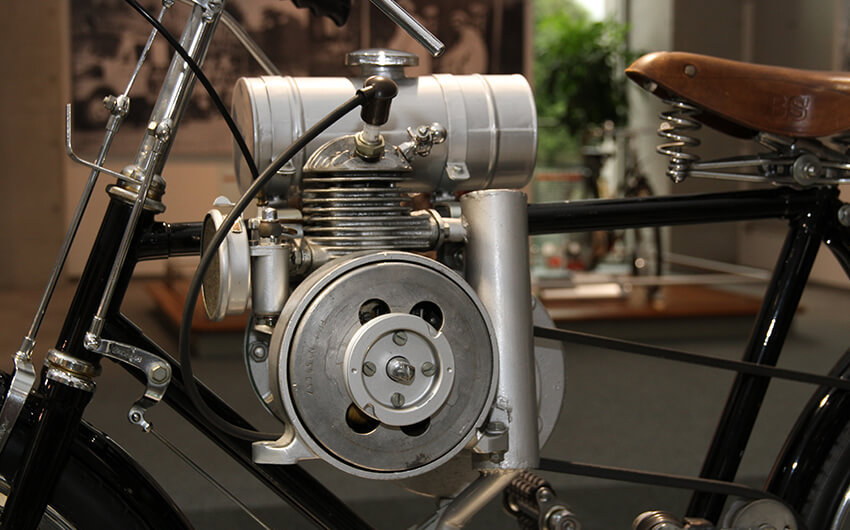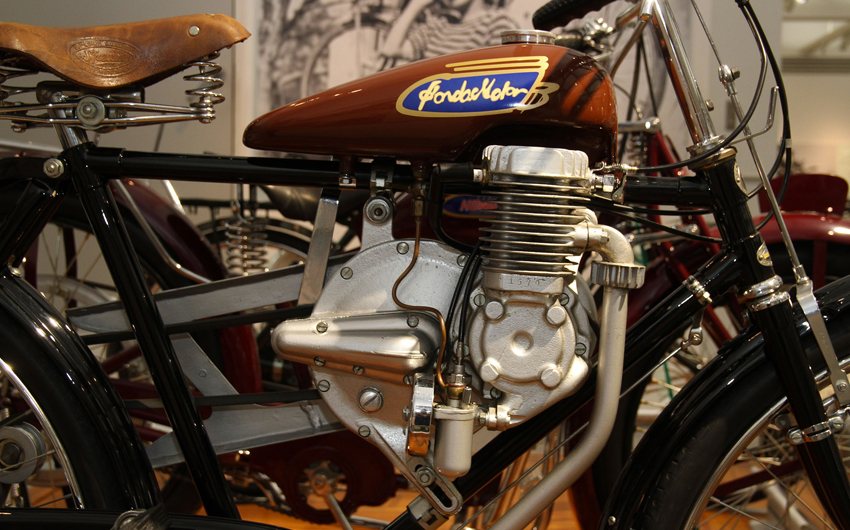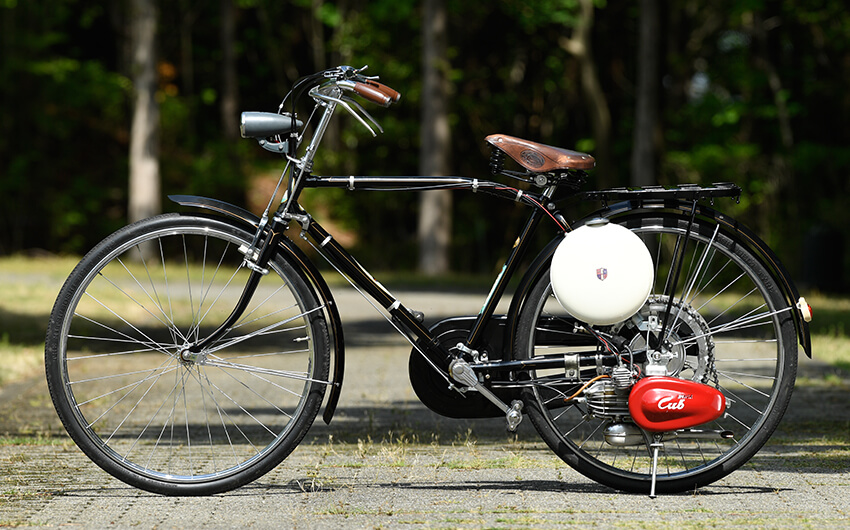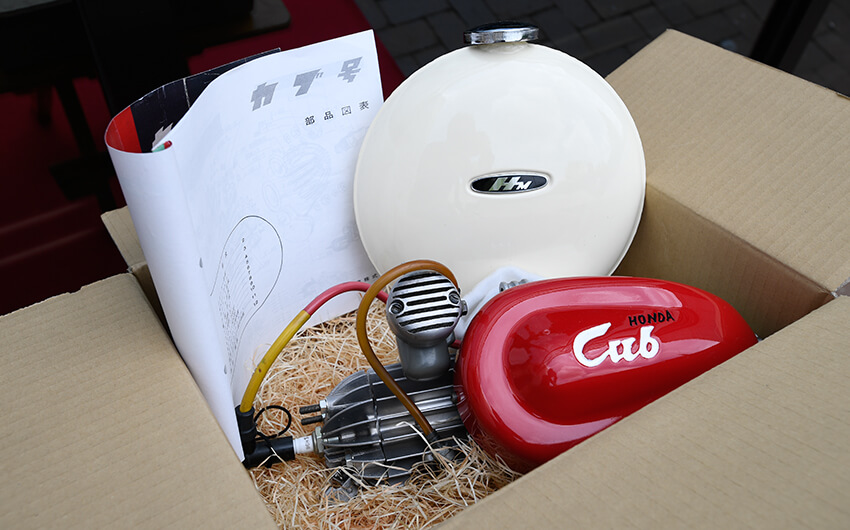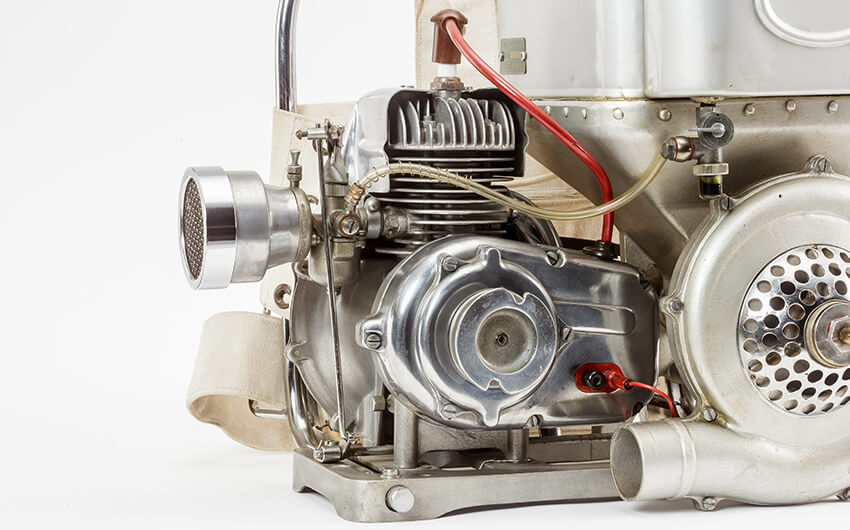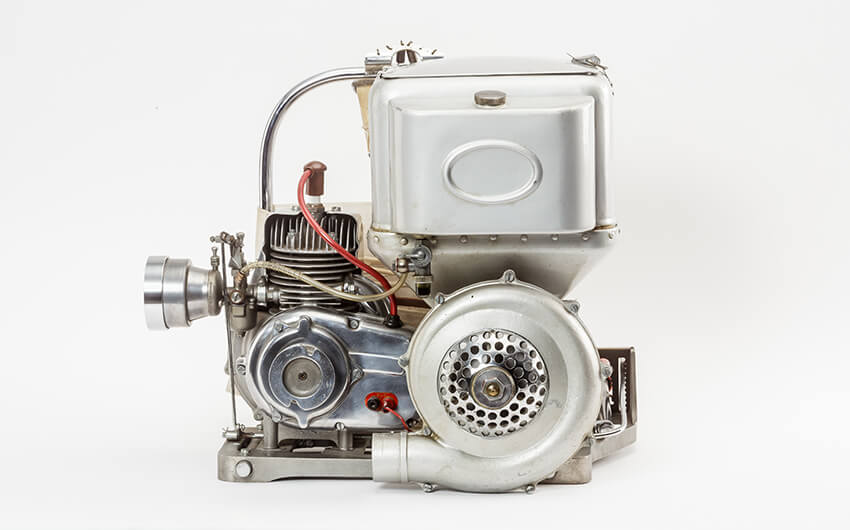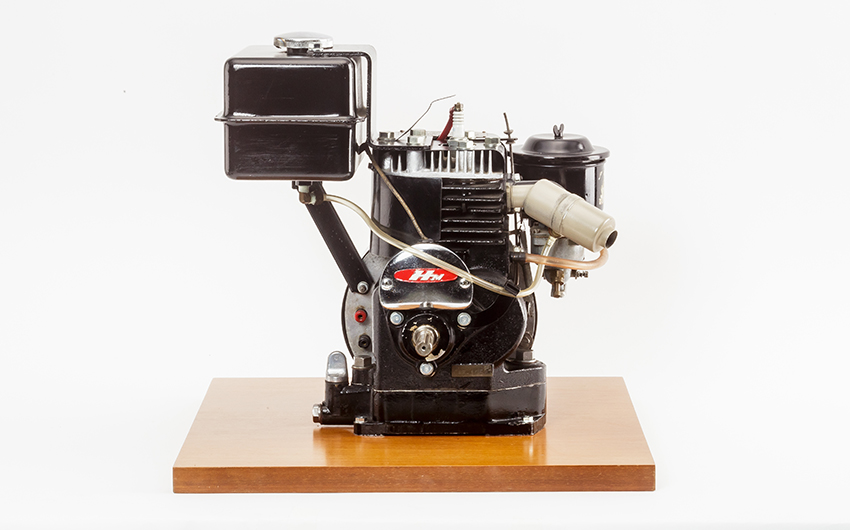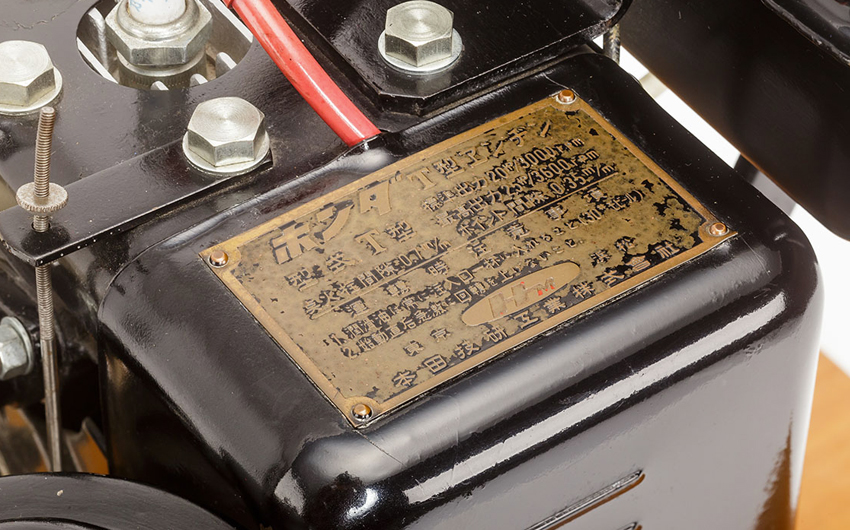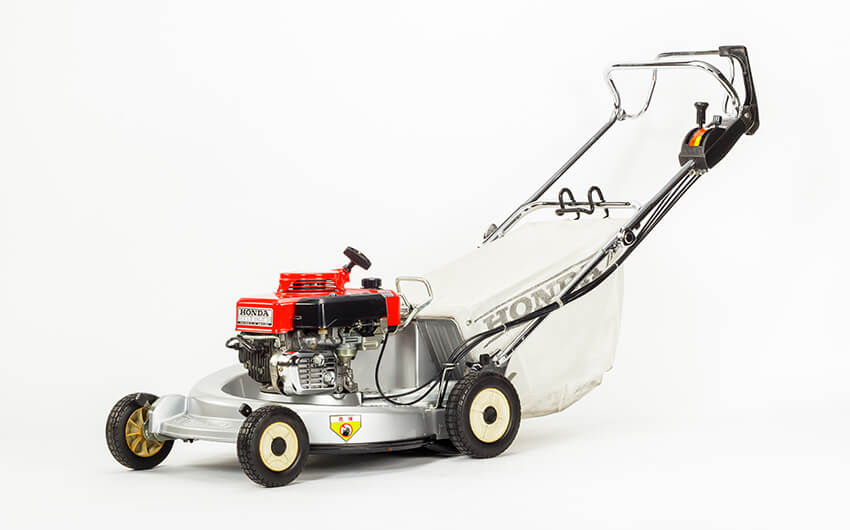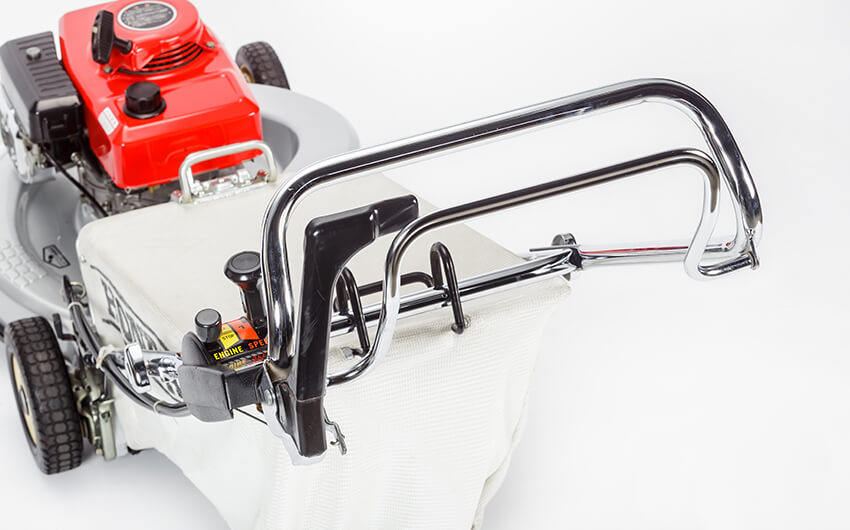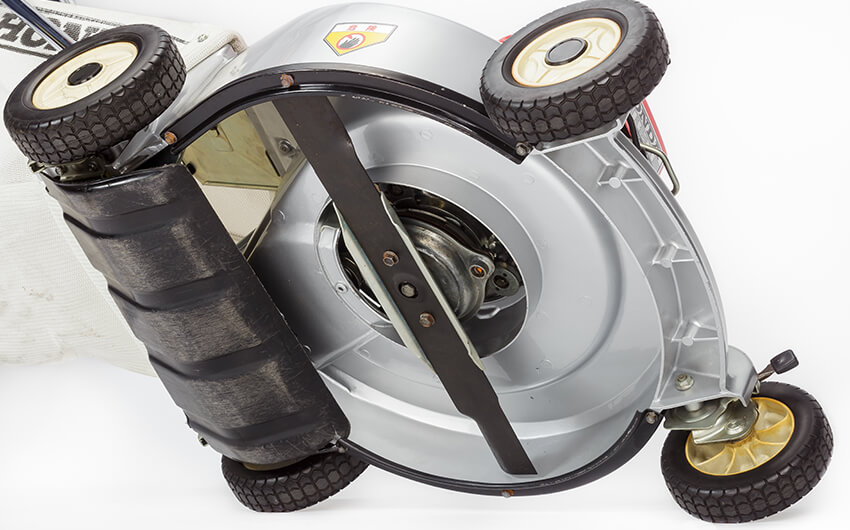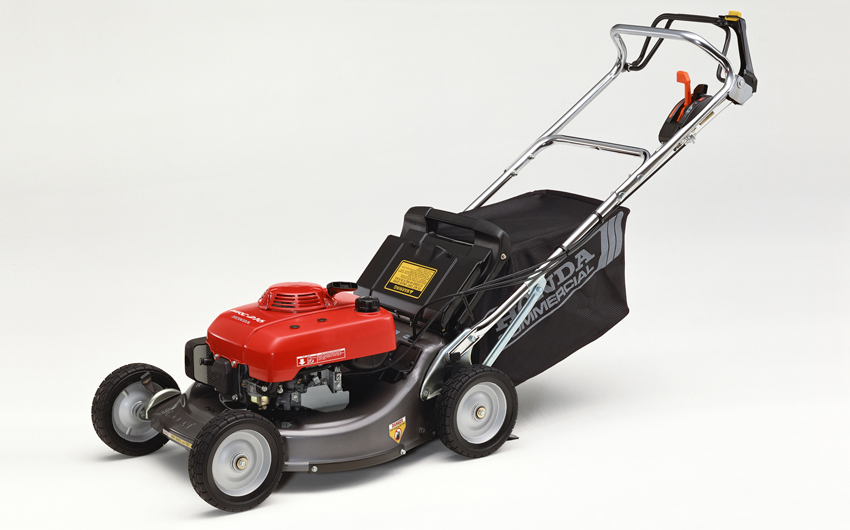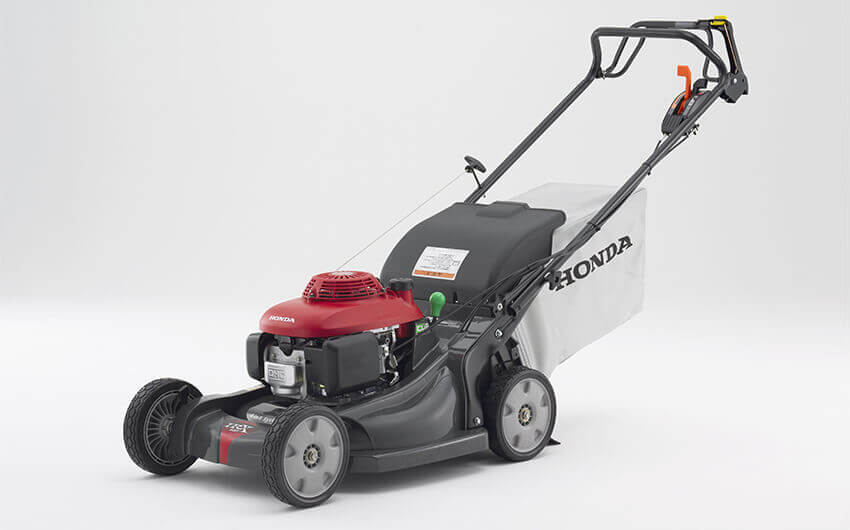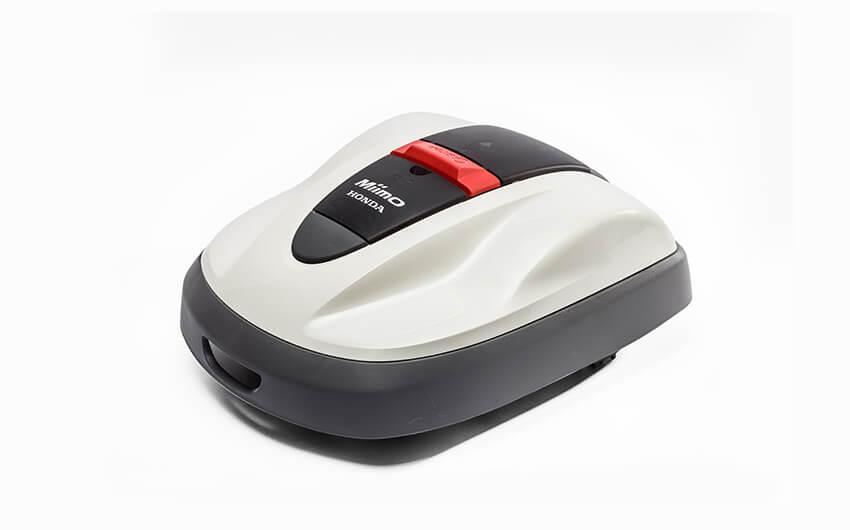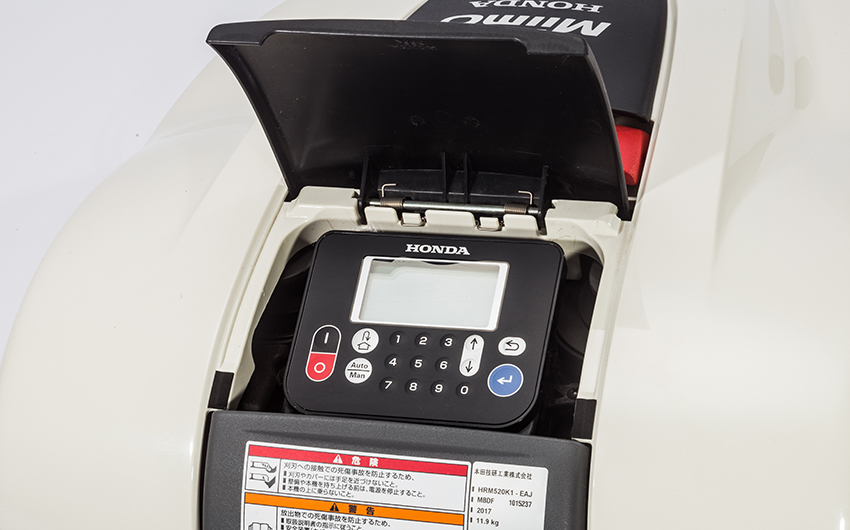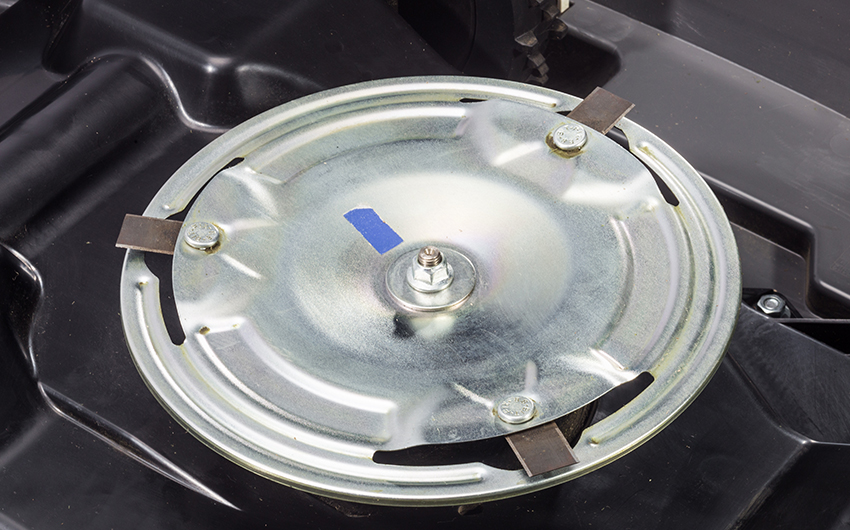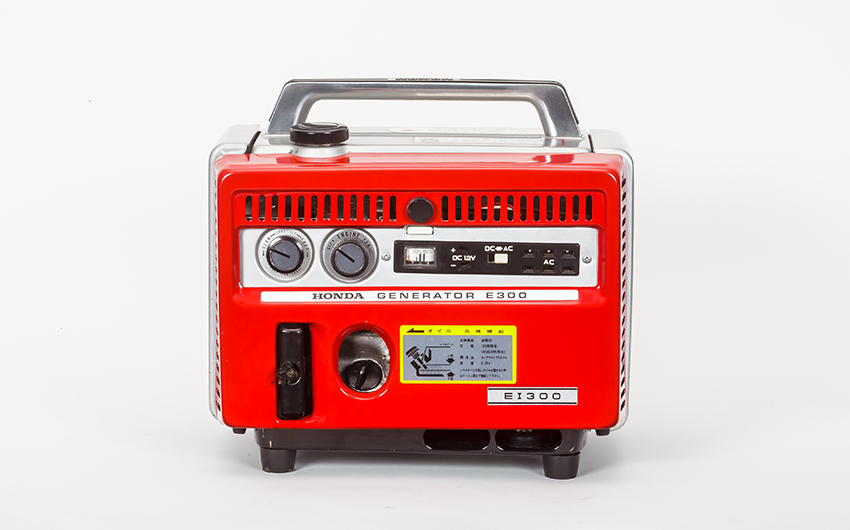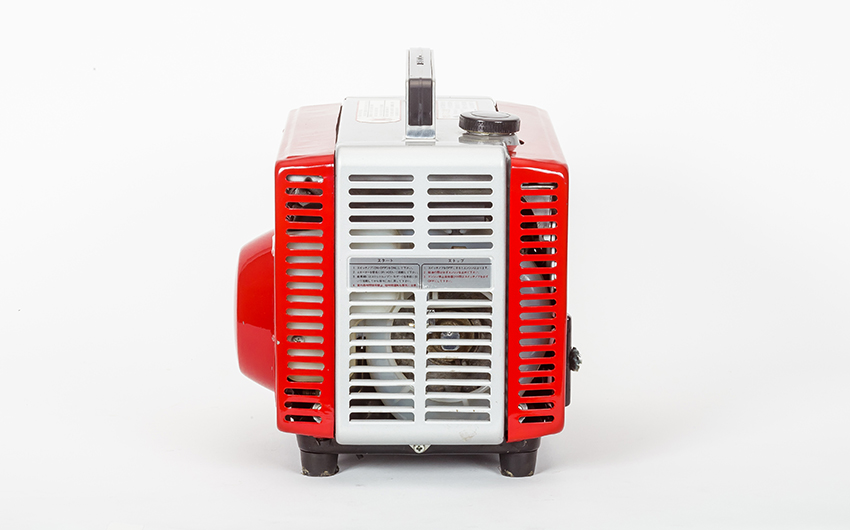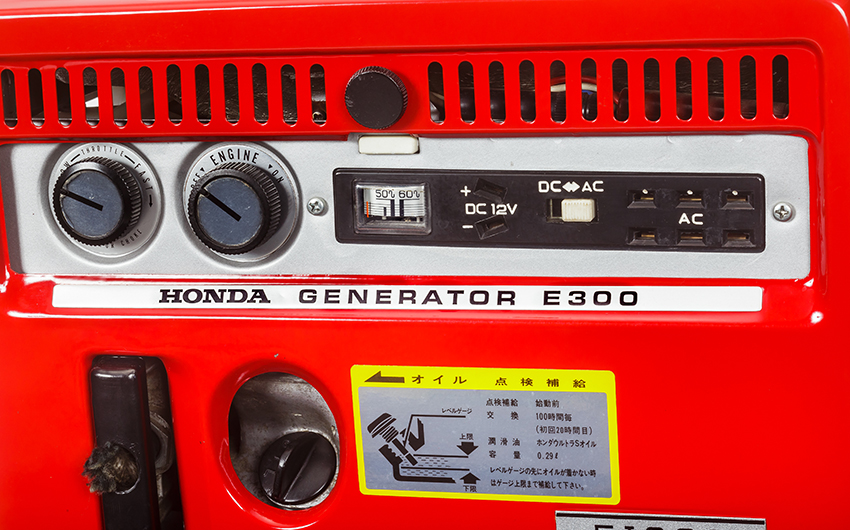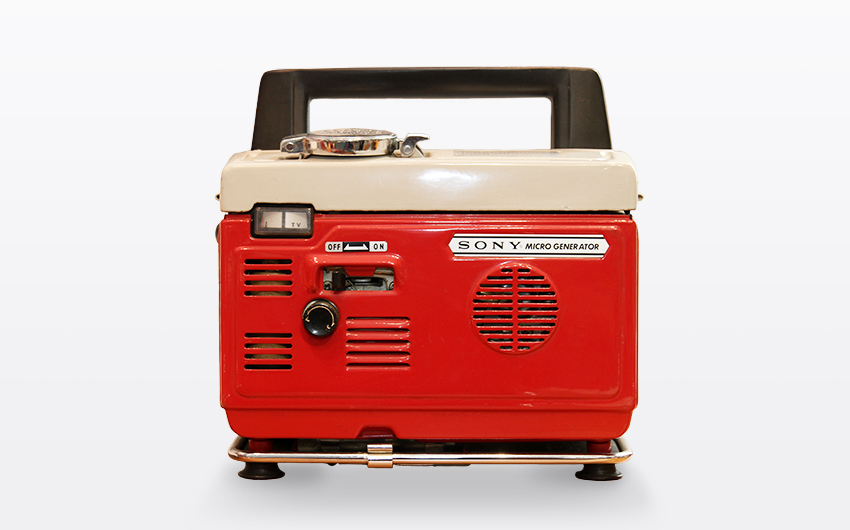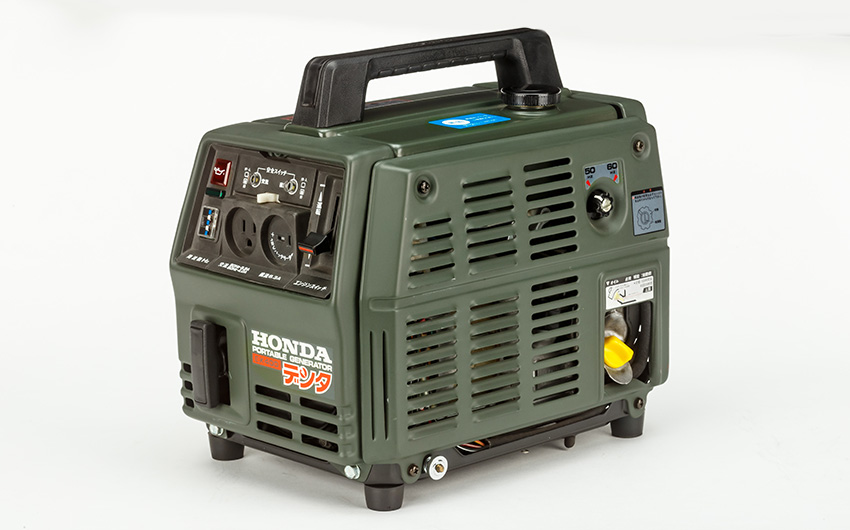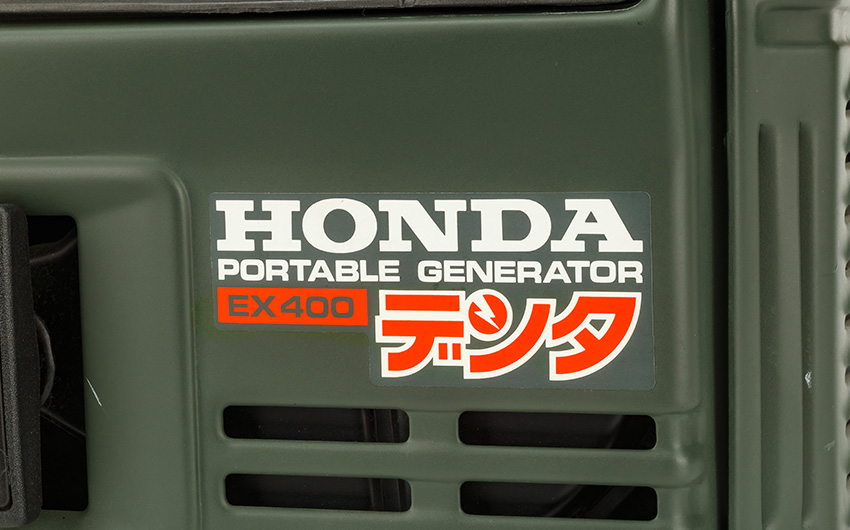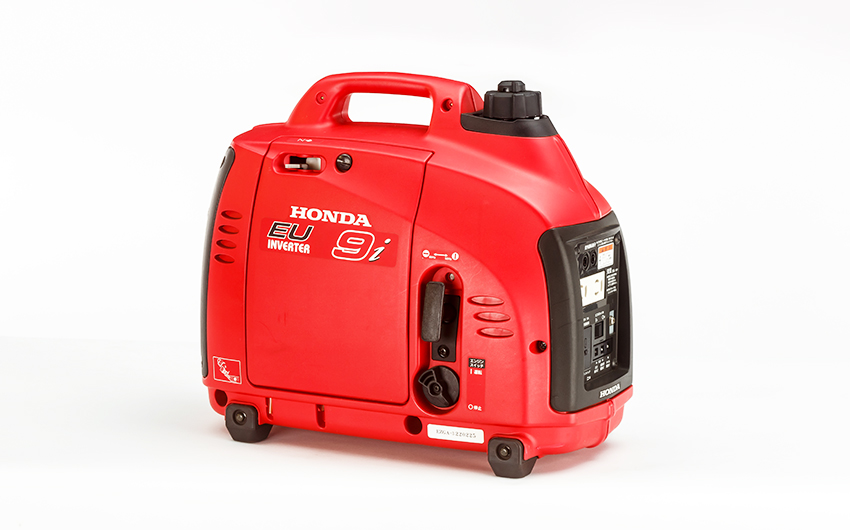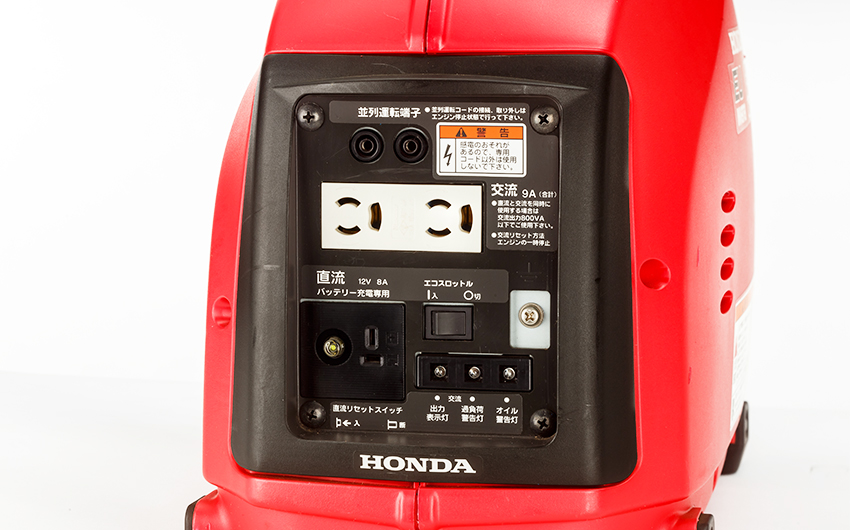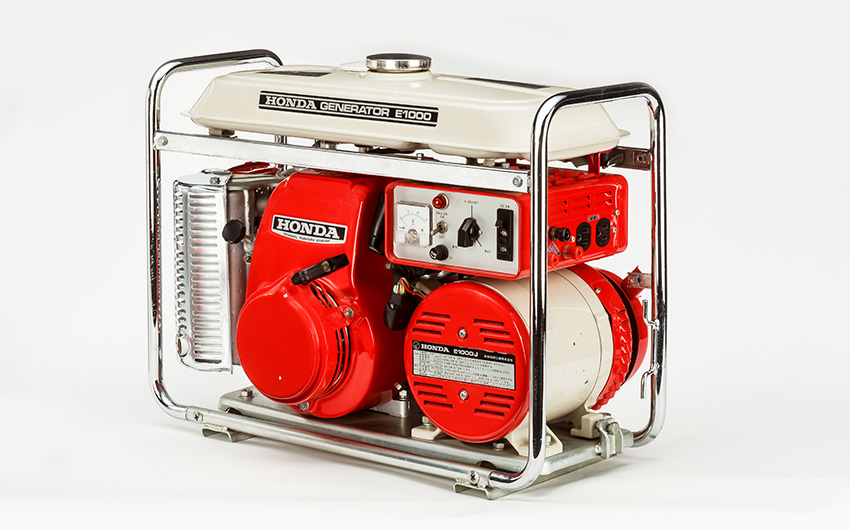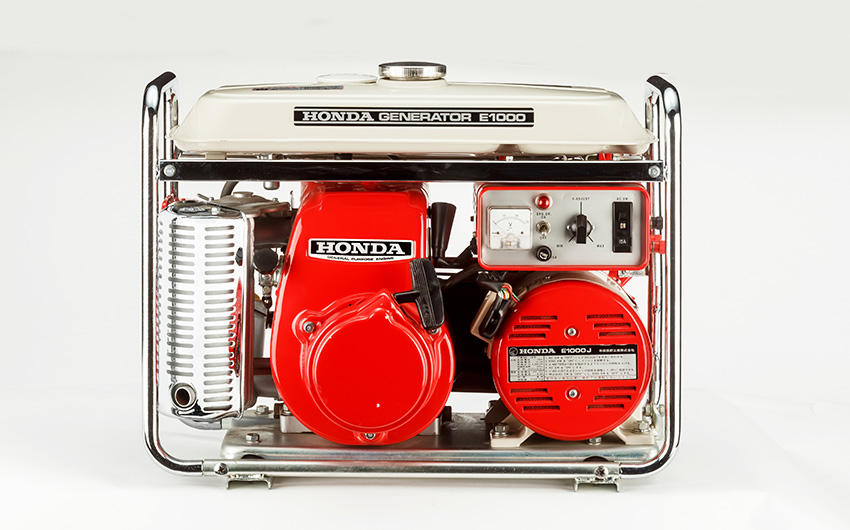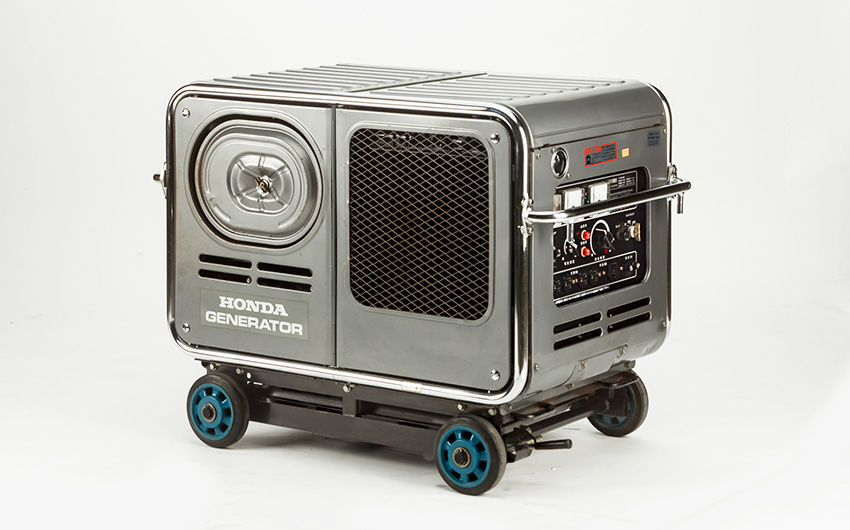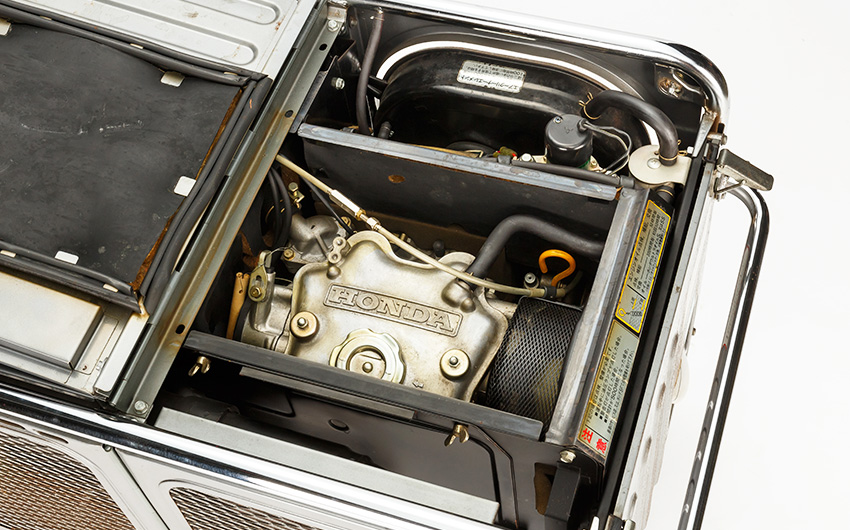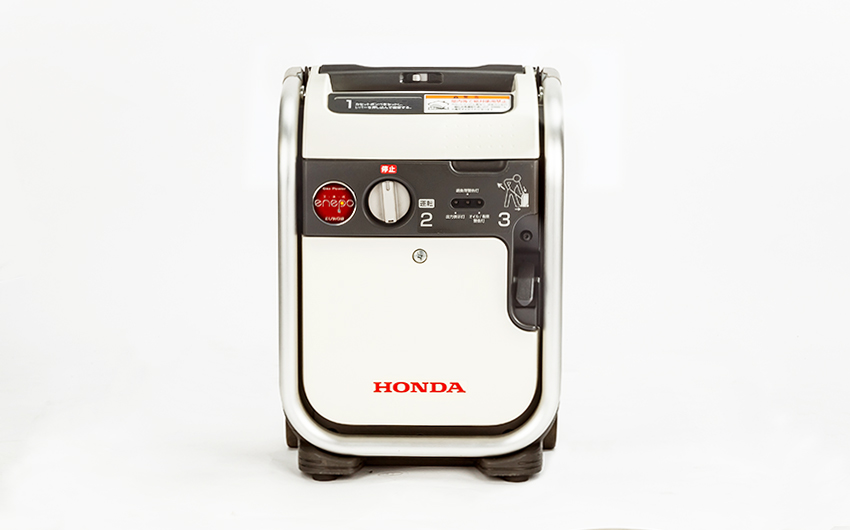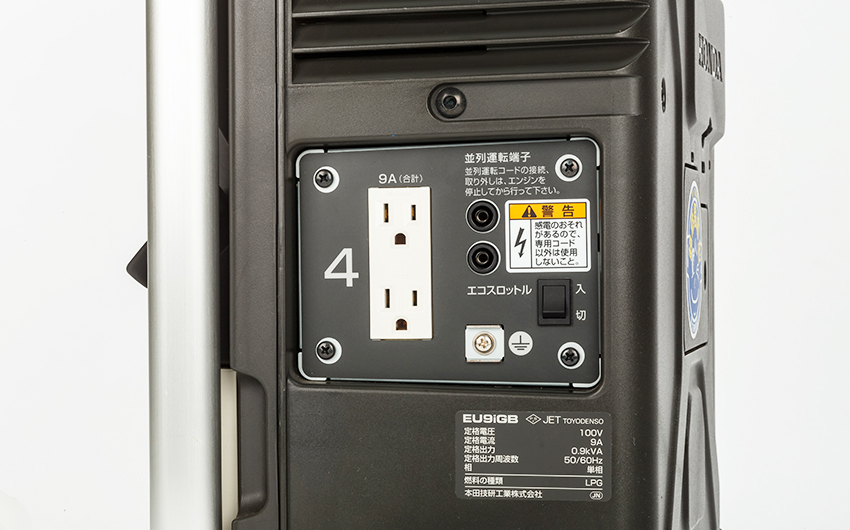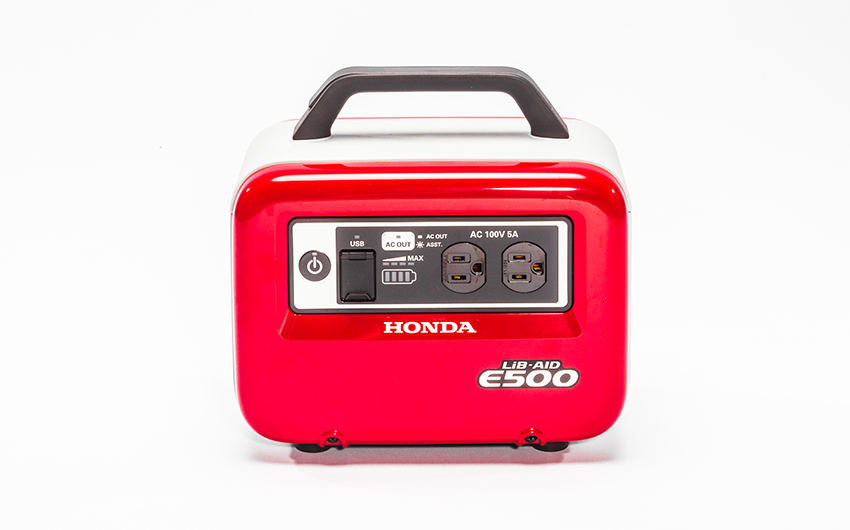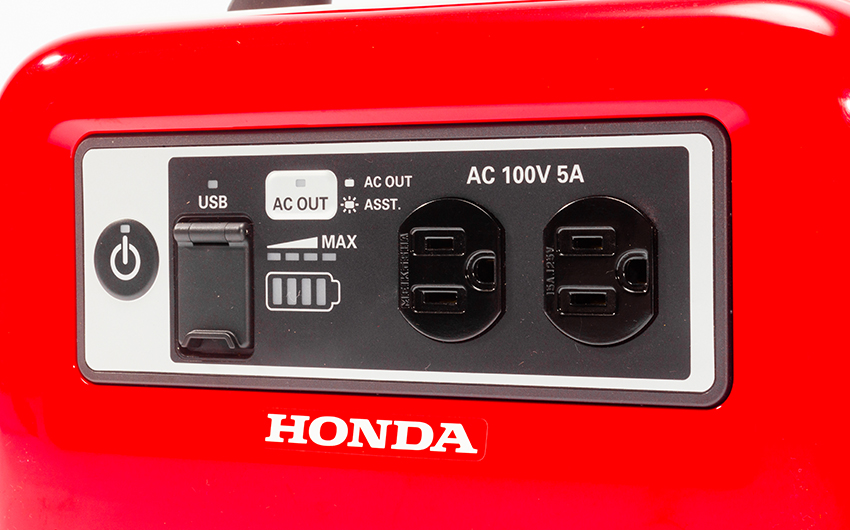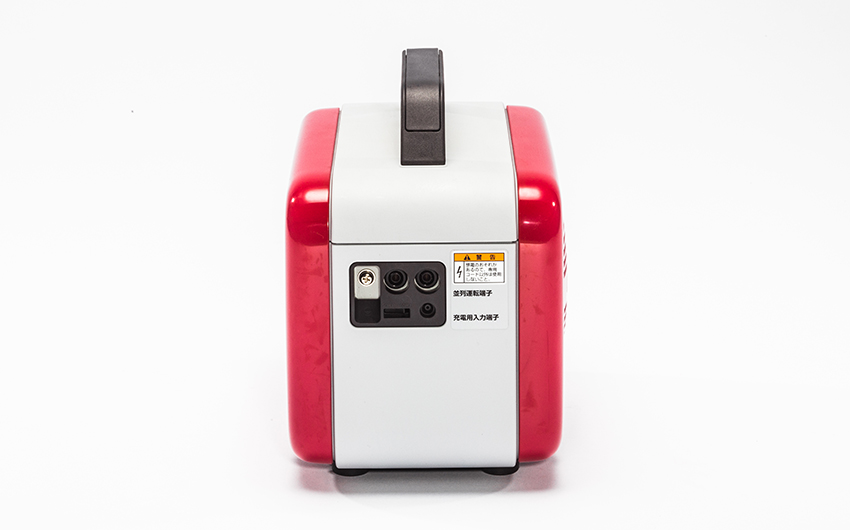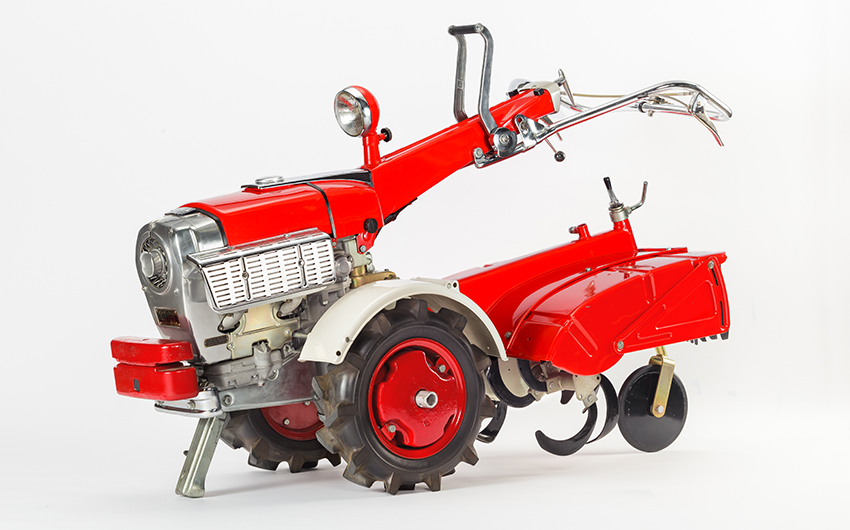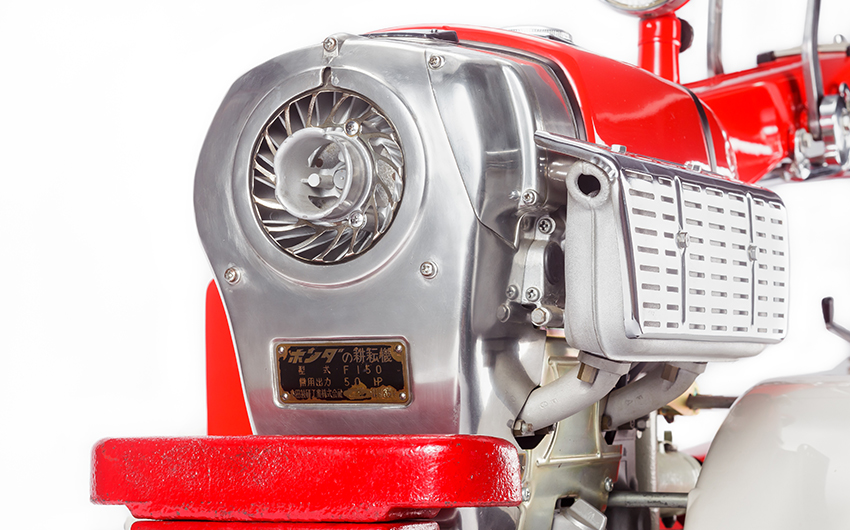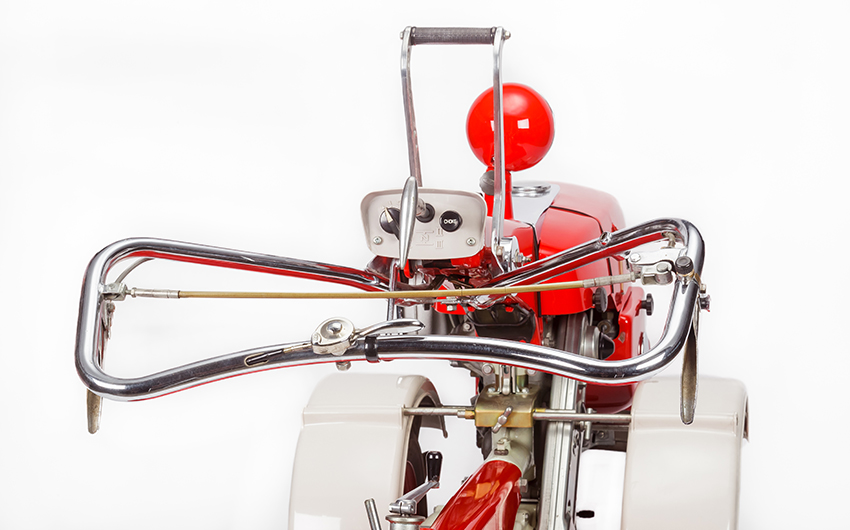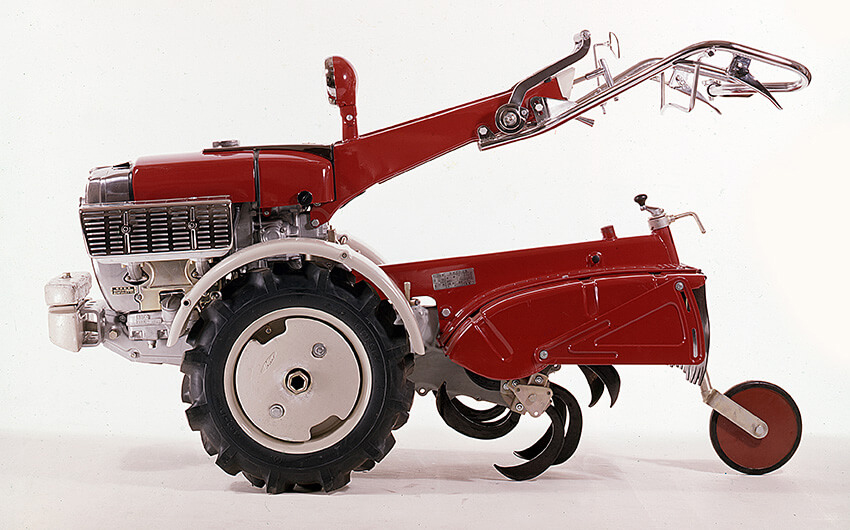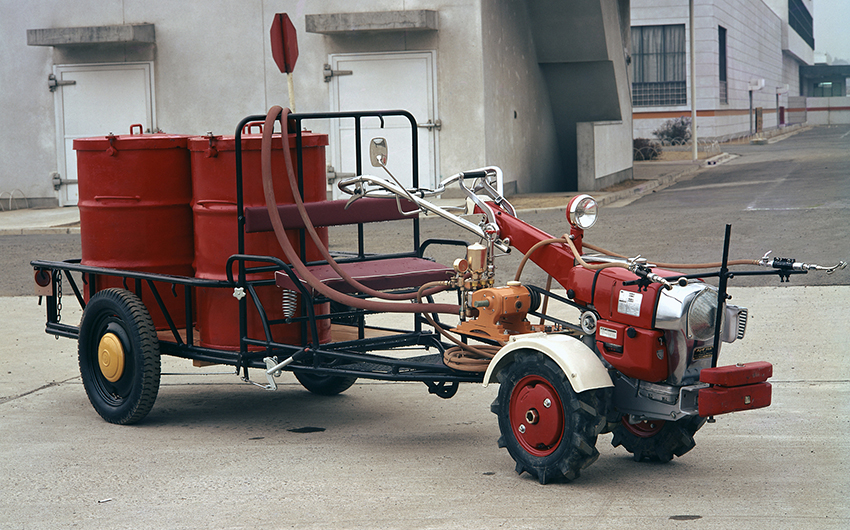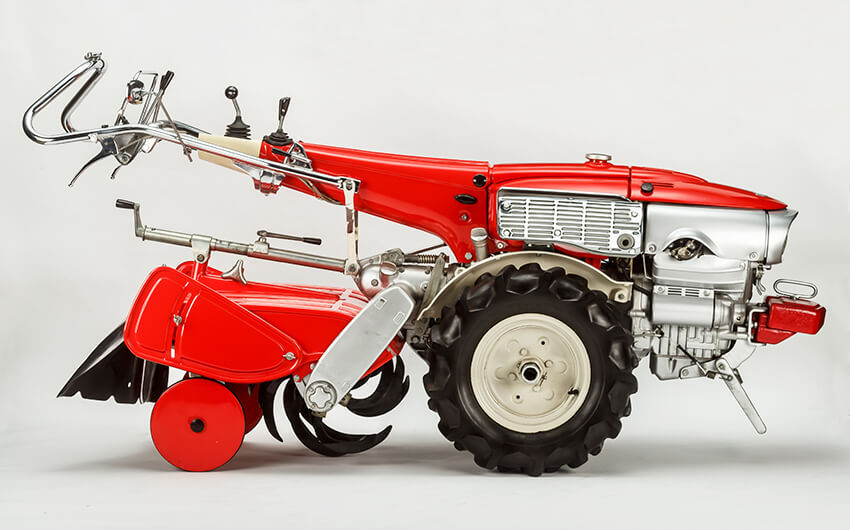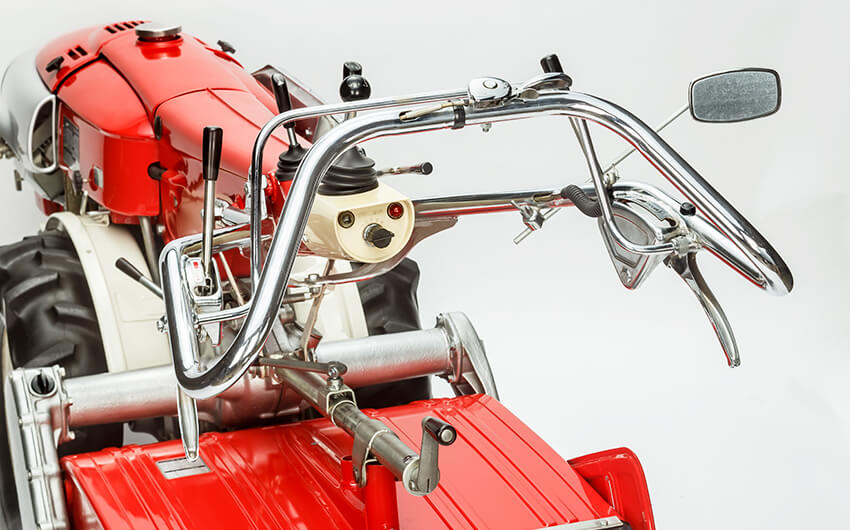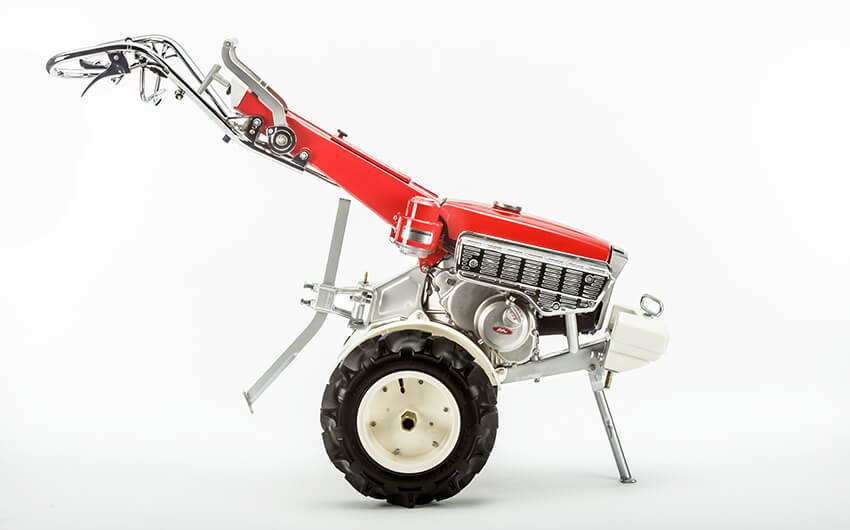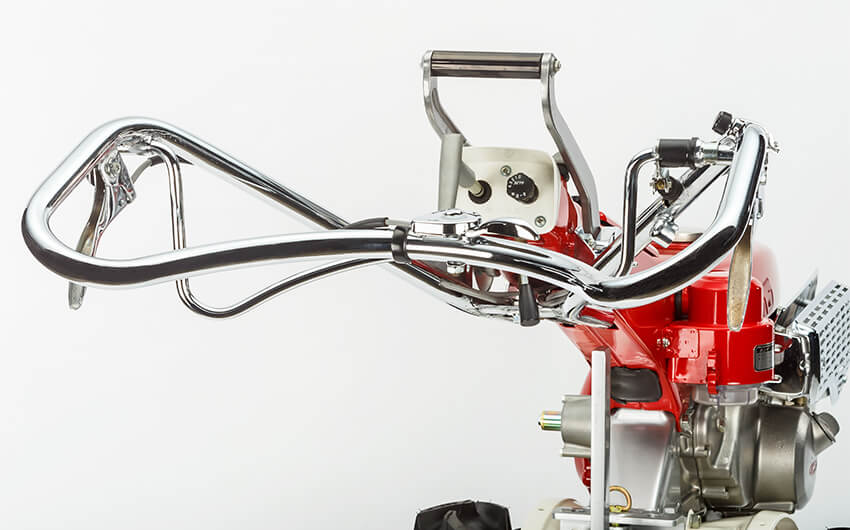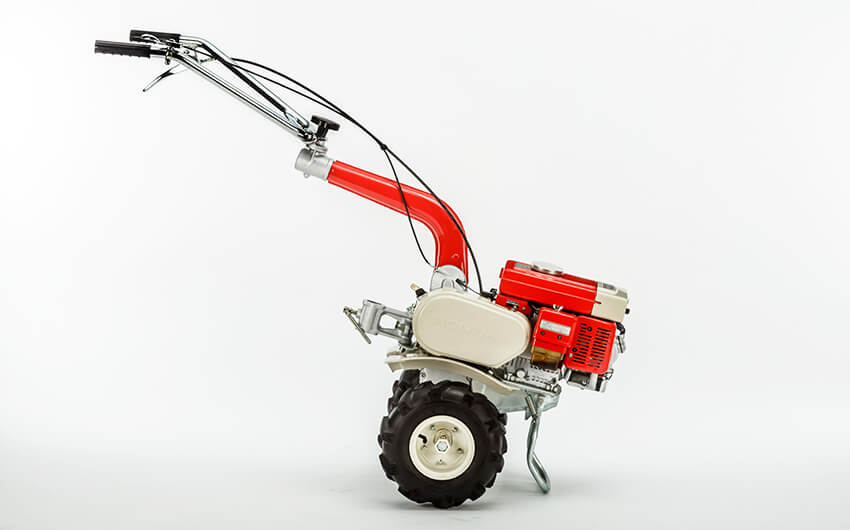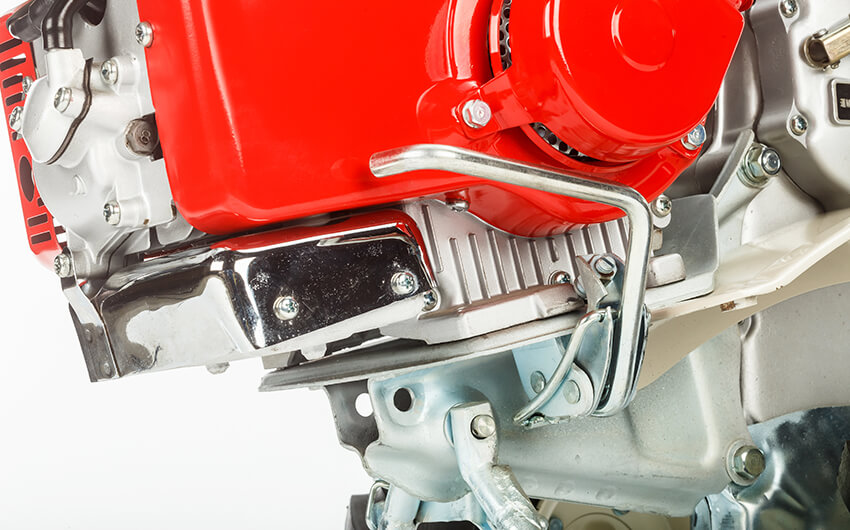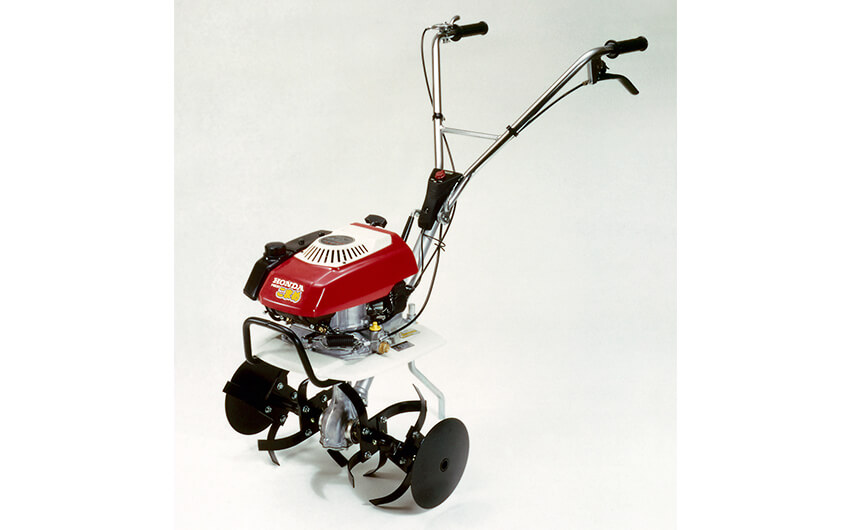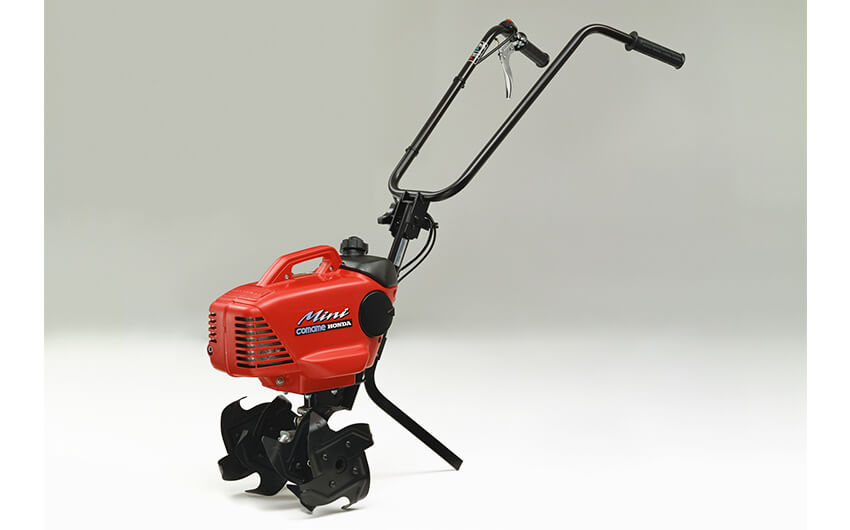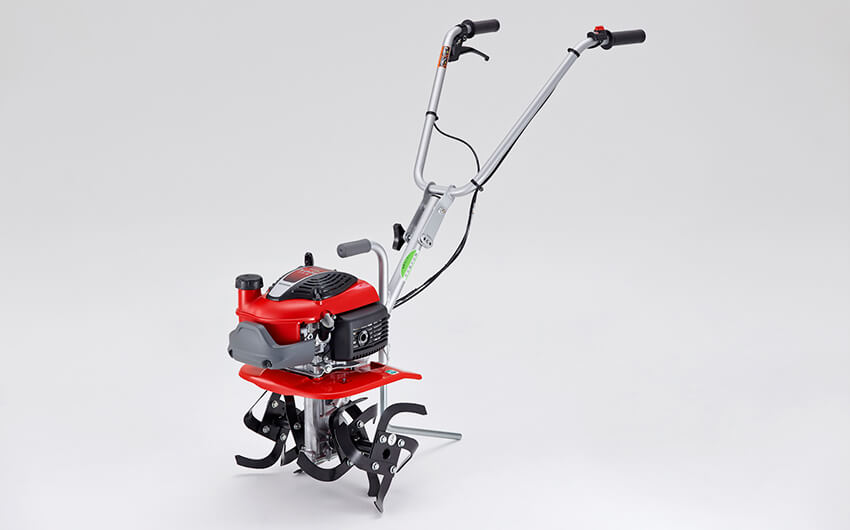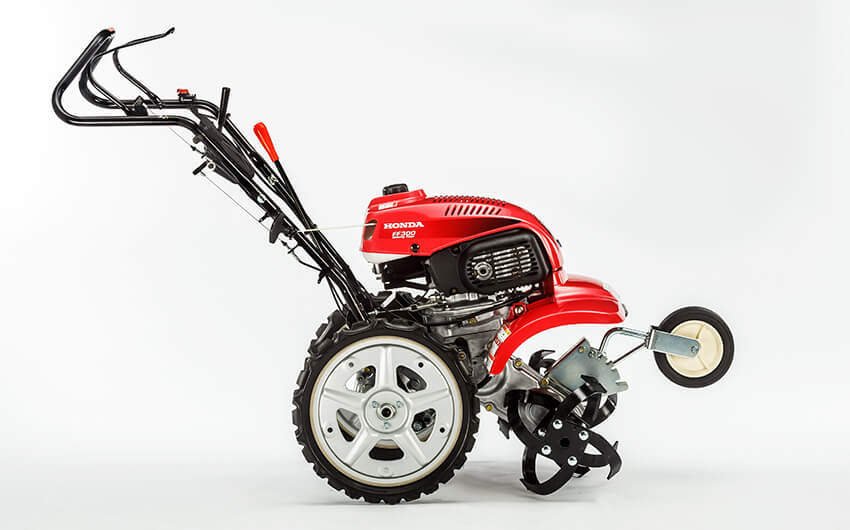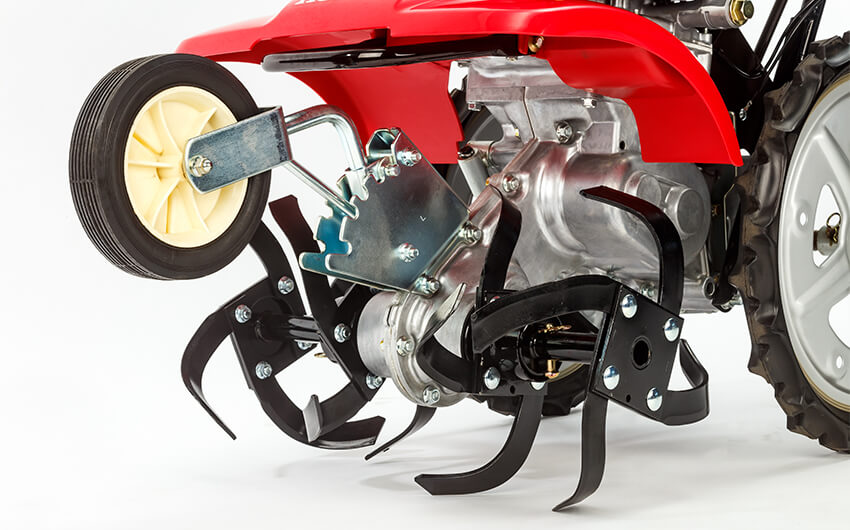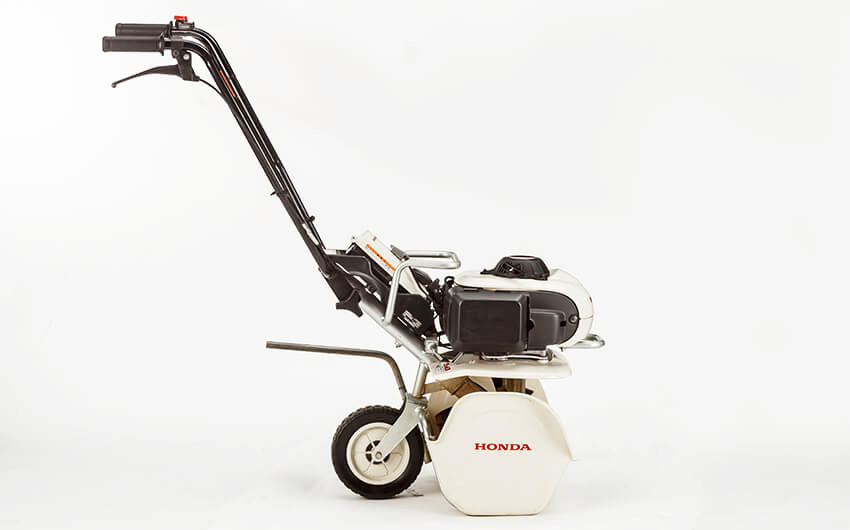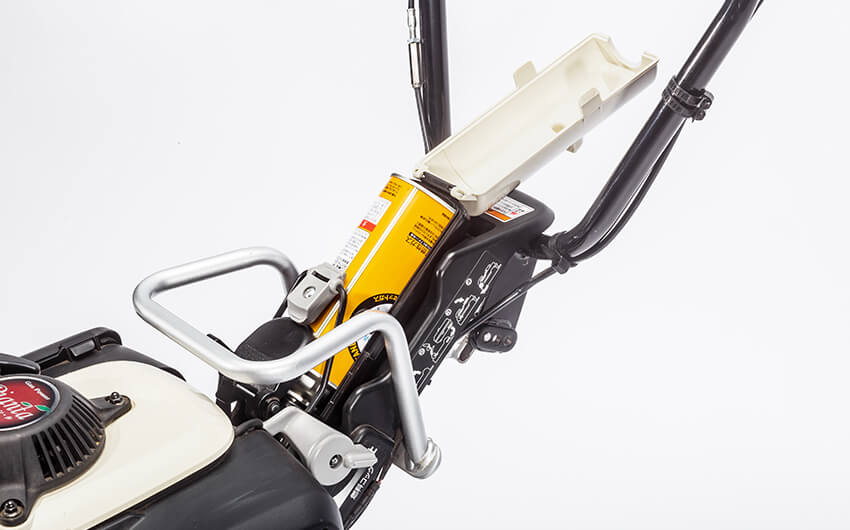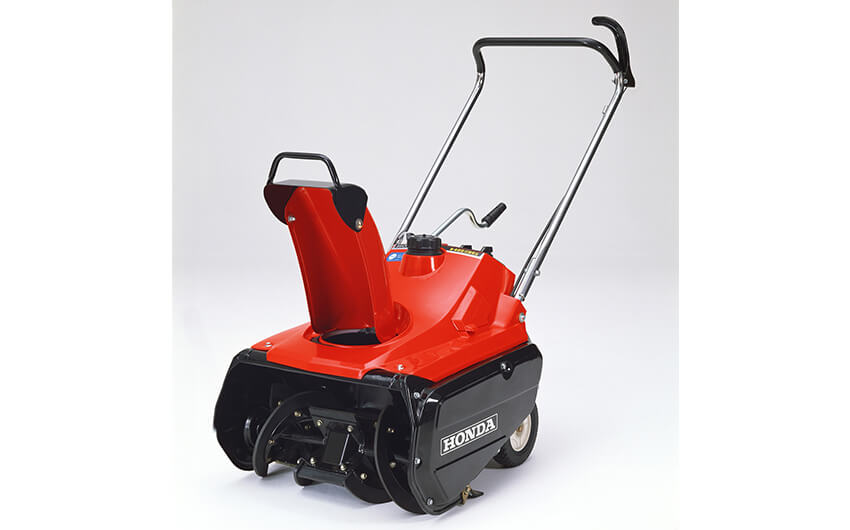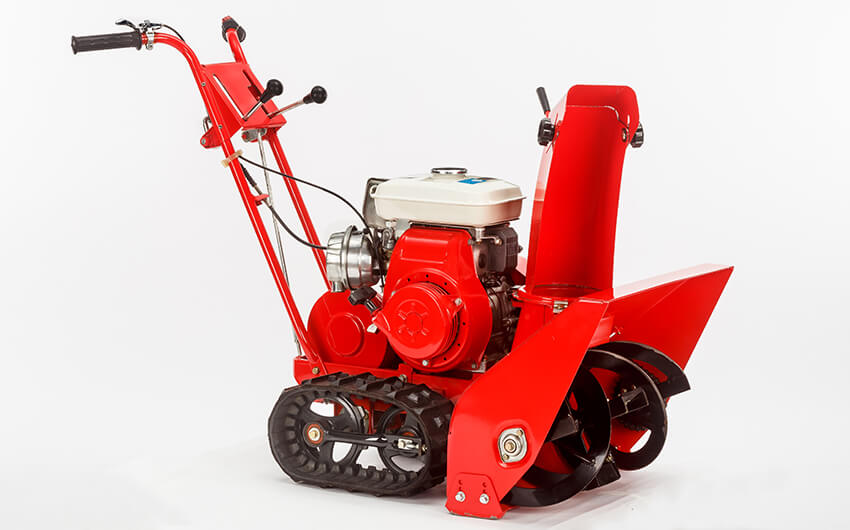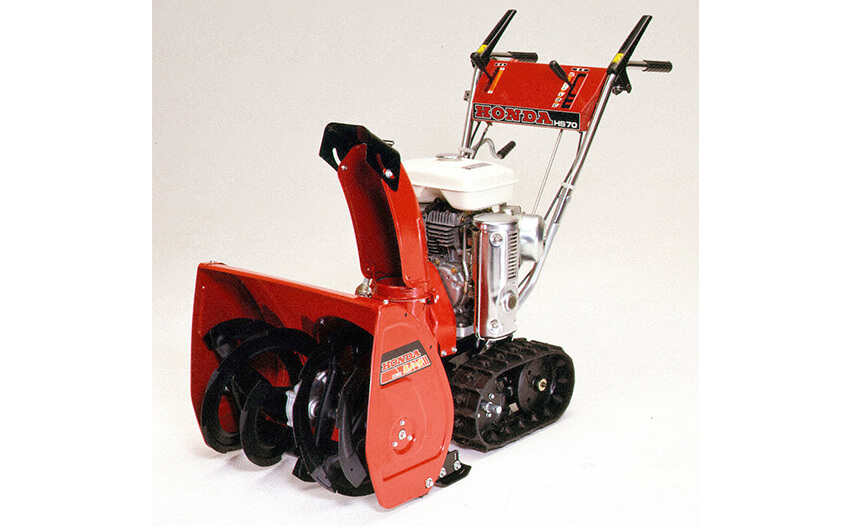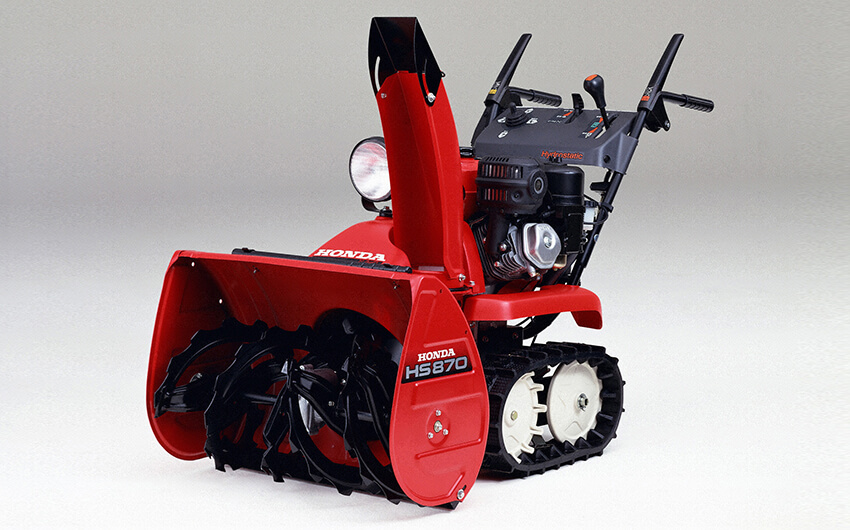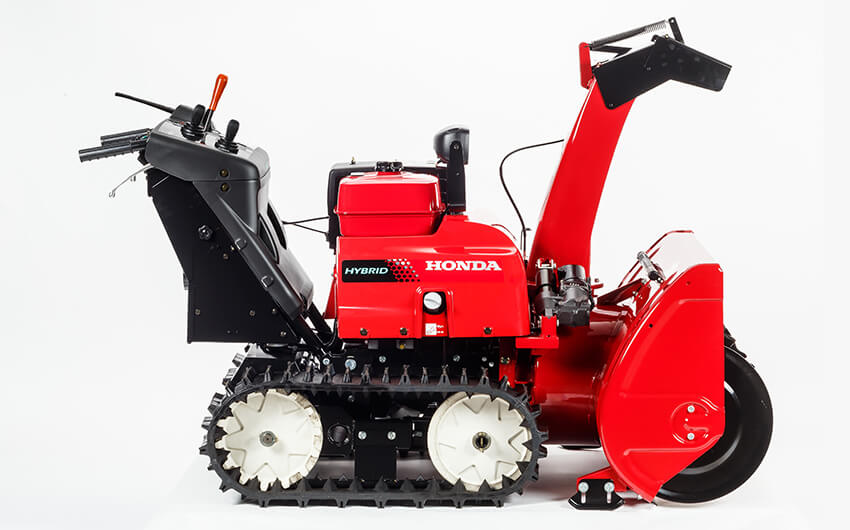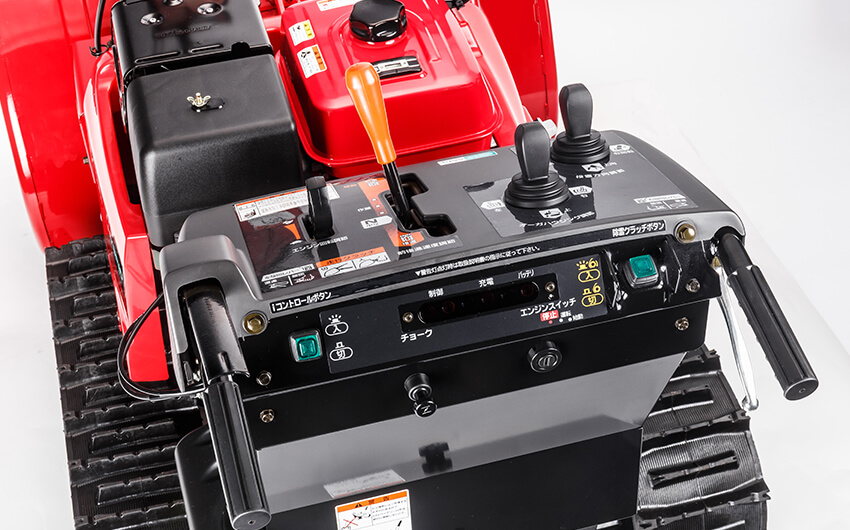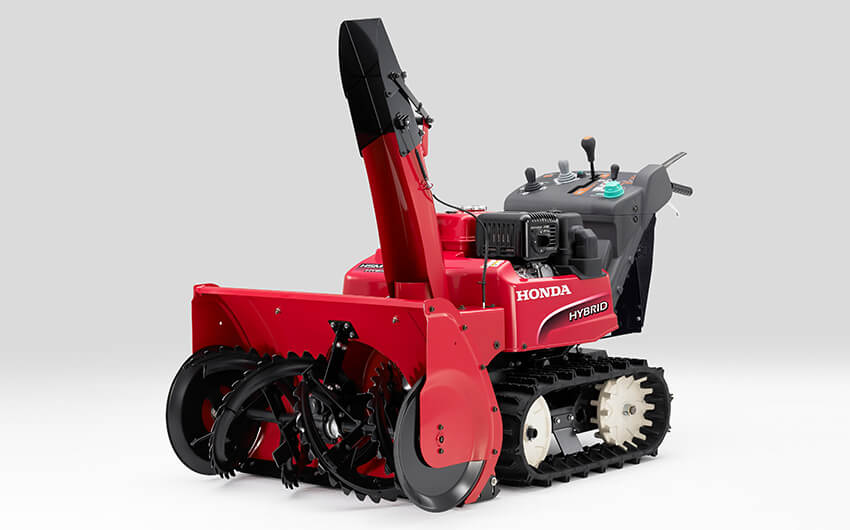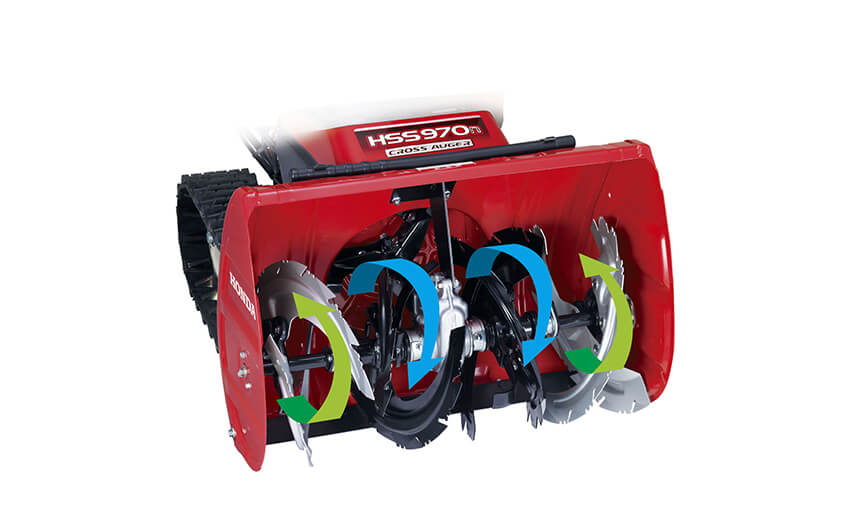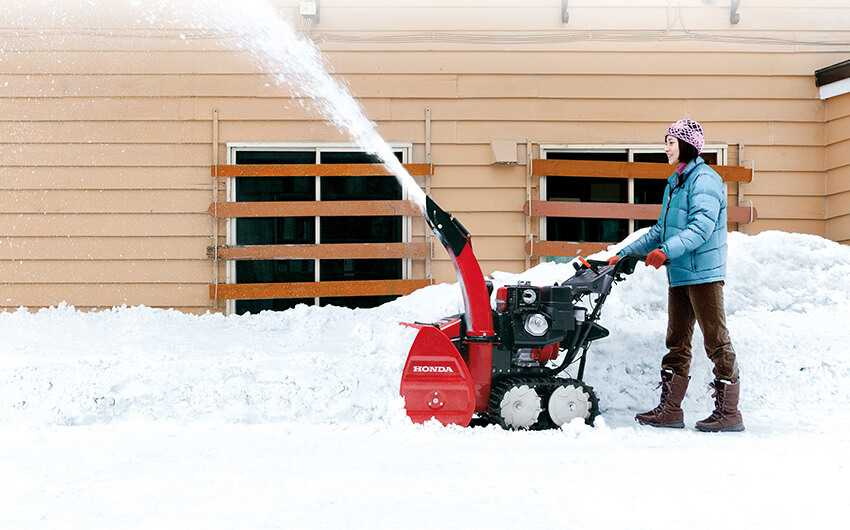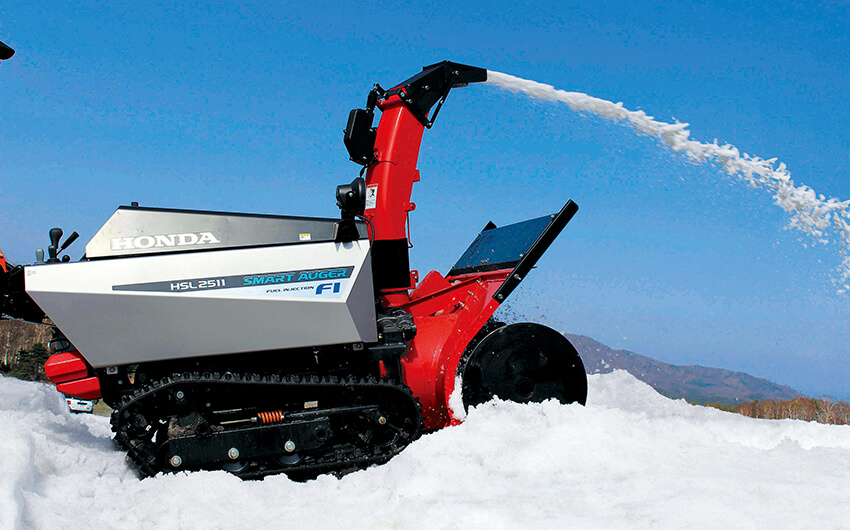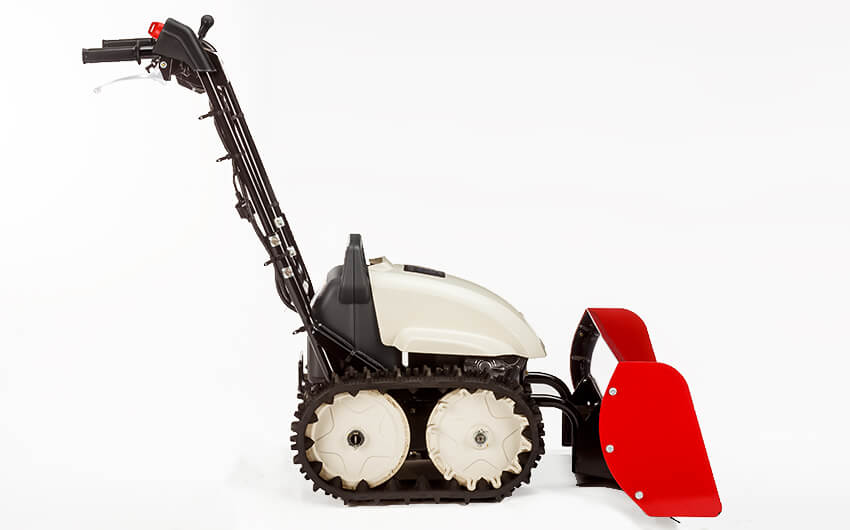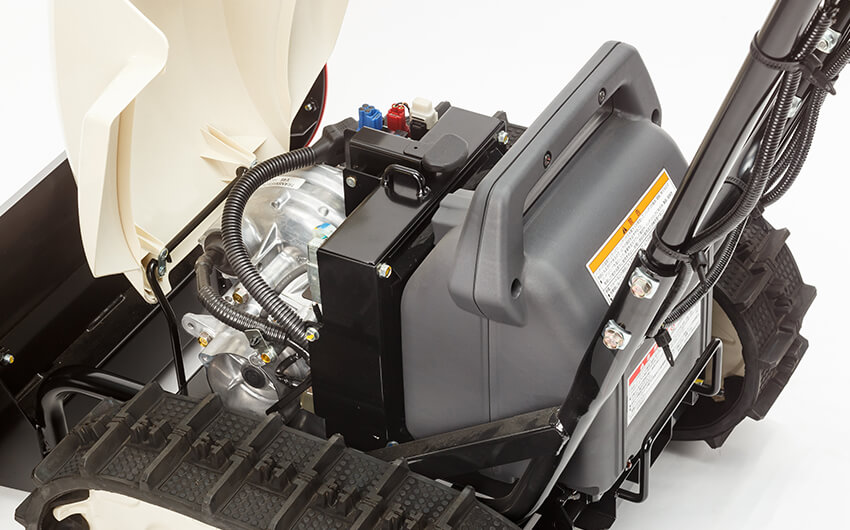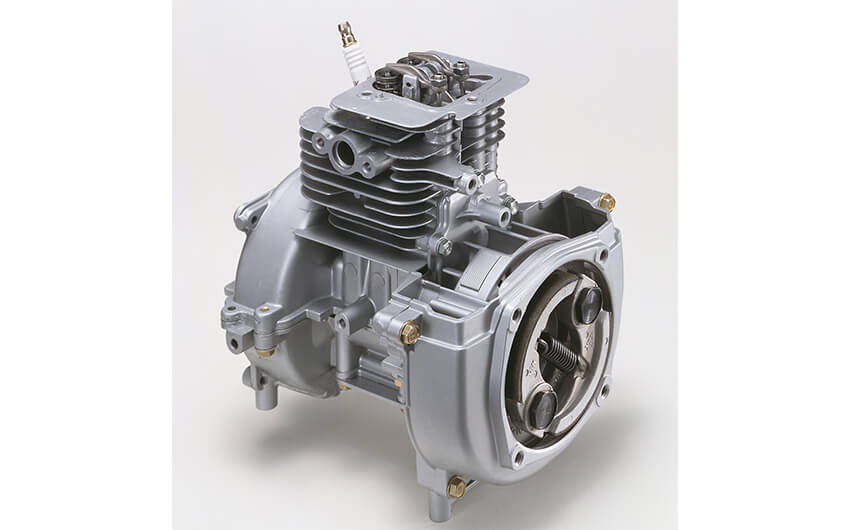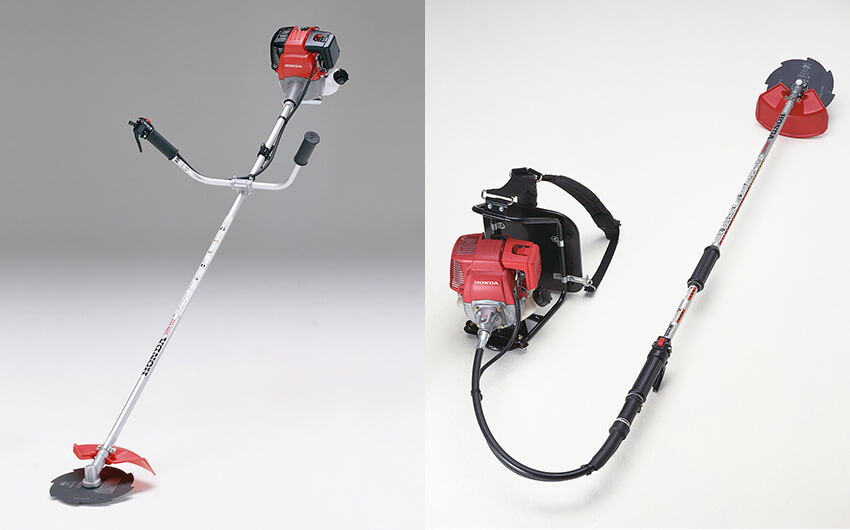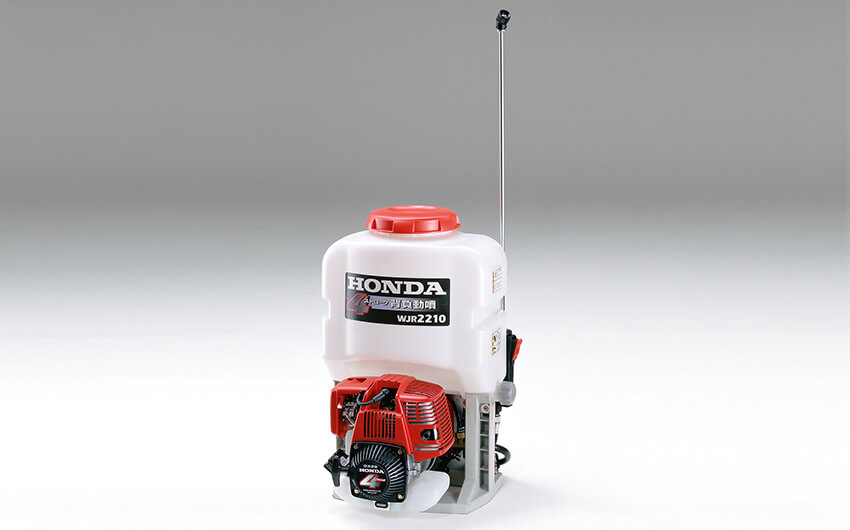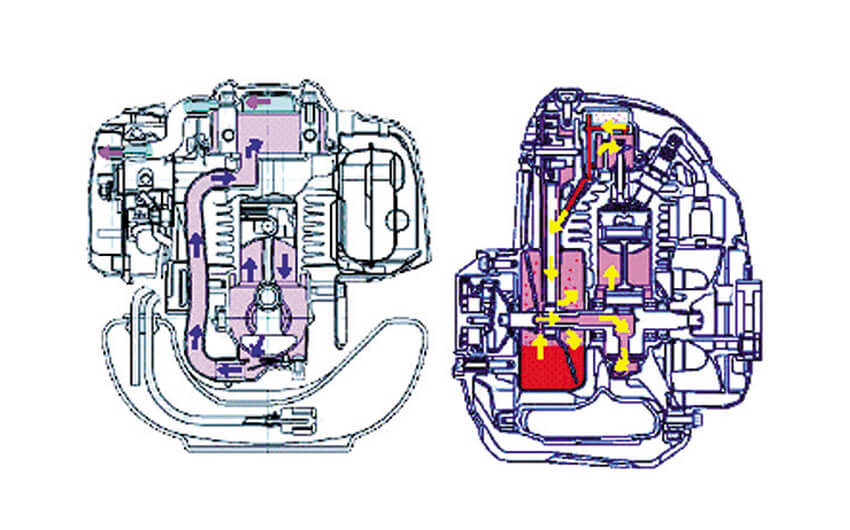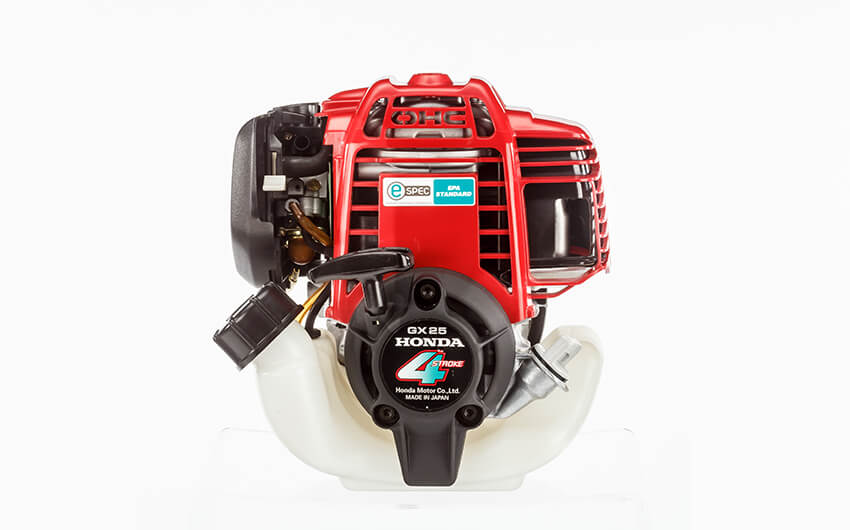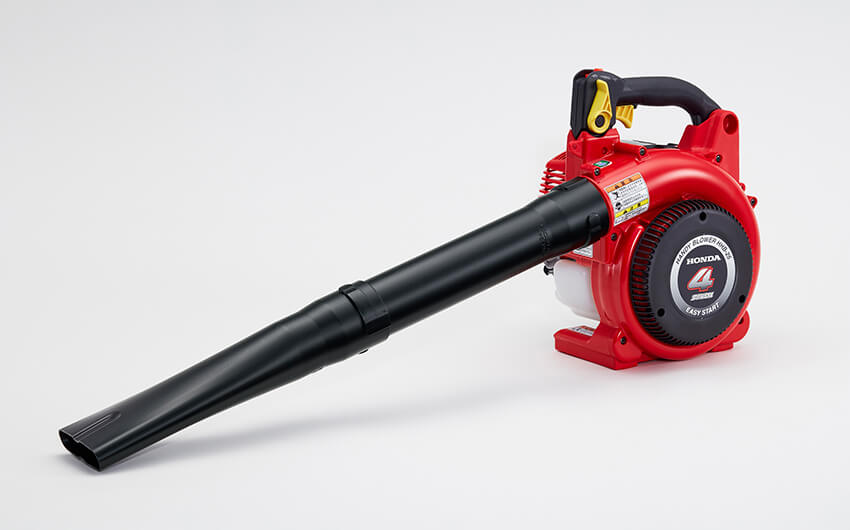Technology
It all started with the engine.
With its excellent quality and reliability,
it gave people everywhere the power they needed,
at work and in their leisure time,
But it has always been more than just an engine.
It is the power source driving our hearts, our lives and our dreams.
Engines
Soichiro Honda’s very first bicycle-mount auxiliary engine was developed and released in 1946. Having acquired a large consignment of engines that had been originally designed to power army radios, Soichiro modified them so that oil and exhaust fumes would not dirty the clothes of the rider. Every part was dismantled and cleaned prior to shipping, and the bicycles were test-ridden after reassembly. In those days of postwar poverty, it would have been enough for the bicycle to simply move. However, no effort was spared in making sure these engines were easy to use and breakdown-free.
This led to Honda’s engines quickly gaining a reputation for running well with a minimum of failures. Soon, that initial consignment of 500 engines ran out, prompting the development of a new engine. Honda’s first completed engine was dubbed the “A-type,” an air-cooled two-stroke 50cc single-cylinder type.
The new Honda A-type was specially designed with die-cast construction. Die casting had the merits of reducing the number of parts, as well as the number of production processes, and greatly reducing the volume of waste metal shavings. However, at the same time the huge initial investment costs to gear up for mass production seemed reckless for such a small-scale factory. Still, with priority given to reducing the weight of the engine as well as reducing the number of production processes and parts to effectively keep down costs, the decision was made to adopt die-cast production.
Just as planned, the Honda A-type ran exceedingly well, and with a minimum of breakdowns. Careful attention was paid to incorporating safety features into its design, such as placing the exhaust pipe, which could become extremely hot, in line with the frame to discharge exhaust fumes downward. The nuts and bolts in common use at the time suffered from a poor degree of precision and often came loose. Honda introduced new innovations in key locations to prevent troubles from arising if a nut ever worked loose. The Honda A-type was also designed so that it could be disassembled without the need of special tools, and it soon won an excellent reputation at the bicycle shops that handled it.
The easy-to-install Cub F also became a colossal hit.
The Honda A-type auxiliary engine was produced through to 1951. Its successor, the Cub F bicycle-mount auxiliary engine, was designed with special consideration given to being simpler, easier to use, and even more durable. At 25,000 yen—then roughly three months starting wages for an average white-collar worker in Japan—the Cub F was high-priced for a bicycle engine. However, Honda’s reputation for excellent quality transcended price, and based on its reliability and ease of use, this meant that people were willing to pay more for a Honda product, pushing sales to over 25,000 units in its first year of production.
By the time the Cub F was released in 1952, seven years had passed since the end of the war, and the recovery of the Japanese economy was steadily progressing.
Honda’s first general-purpose engine, the H-type, was developed to power a backpack-style crop dusting machine.
Industries like construction, agriculture and fishing were shifting more and more away from human labor to mechanization. Later that year, in September of 1952, Honda announced the release of its first general-purpose engine, the H-type, a forced air cooled, 2-stroke 50cc single cylinder that put out 1 horsepower.
The H-type’s main component parts were formed of die-cast aluminum, making possible a lightweight and compact engine that weighed a total of 6kg. As starting up most engines of the time was often hard work, its double-pull rope-type manual starter was well received. The H-type was also OEM supplied as an engine for powering backpack insecticide dusters, of which over 5,000 units were exported to coffee plantations in Brazil.
At the time, the vast majority of general-purpose engines were either noisy, vibrating 2-strokes that gave off noxious fumes, or big, heavy and hard to handle liquid-cooled diesels, which ran on smelly kerosene. By switching to a 4-stroke configuration, reduced vibration, better fuel economy, and far fewer unpleasant smells could all be realized, while greatly improving long-term durability. On the other hand, the actual manufacture of the engine would necessarily be more complicated, resulting in higher costs.
The T-type 4-stroke engine.
Honda took up the challenge of creating a 4-stroke engine that could be easily used by farmer’s wives. In December of 1954, the company launched its T-type farm engine, a compact power source that could be easily used by people who had no prior experience handling engines.
With power output increased to 2.5 horsepower, the T-type was designed to perform reliably even when mounted on farm machinery at an angle, and was equipped with Honda’s first in-house developed carburetor. Its muffler was also designed to not discolor when exposed to high temperatures, enhancing the look of the product as well as its ease of use.
Japan’s economic growth began to surge in the 1950s. Young people from poor farming villages started to pour into the cities as labor. The sudden decrease in the number of young people on the farms resulted in them being run more and more by “mom, grandpa and grandma.”
In 1953, the Agriculture Mechanization Promotion Law was enacted in order to promote greater agricultural productivity and improve agricultural management. By 1956, self-feeding threshers were in use by over 2.7 million farms, half the total number of farming households in Japan. The mechanization of farming steadily progressed as the labor force continued to dwindle.
The market for agricultural machinery in Japan was soon monopolized by a small number of specialist manufacturers, leaving little room for new manufacturers to enter.
At the time, the farm machinery market was dominated by large, heavy, and troublesome ‘professional use’ items, with few farm tools to be found that farmers wives could easily use.
Under these circumstances, Honda’s idea of wanting to “put a Honda-powered product in each home to reduce labor and increase productivity, and make Japan a richer country” was further strengthened by the establishment of a new Agricultural Machinery Design Division in 1958.
Rather than being content with merely building engines, Honda was taking its first steps in developing and creating finished products that would become integral parts of people’s lives. Of course, the essential idea was always to “make people’s lives better through technology.”
Lawnmowers
These days, lawnmowers are common home and garden tools in both the USA and Europe. Even back in the 1970s they commanded a huge market, with global sales of over 8.5 million, of which more than 5 million were sold in North America.
However, lawnmowers of the time often had starting issues, and many were prone to breakdowns. There were safety issues as well. If not used properly, a lawnmower with a fast-spinning cutting blade could cause serious injuries. Yet, most lawnmower models of the time had virtually no safety features. This led to a lot of accidents, particularly when users tried to remove grass stuck in the cutter housing without first stopping the engine. Consideration was given to creating legislation that would require safety devices, but the many technical problems that arose meant that such legislation ended up being shelved. Still, more people demanded lawnmowers that were safer and easier to use.
Around this time, lawnmowers were still a rarity in Japan. Because of this, new lawnmower development was quite a challenge for Honda. The first step was prioritizing research into actual on-site conditions. So in addition to investigating usage environments and listening to user requests, Honda also collected and actually cultivated various varieties of grass lawns. These investigations were thorough enough that everything from grass growth to mowing conditions through to the disposal of cut clippings was taken into consideration.
Honda’s first lawnmower, the HR21, featured a BBC (Blade Brake Clutch) mechanism, vacuum action, and a host of other innovations.
Research and development progressed based on these investigations, leading to the 1978 release of Honda’s very first walk-behind lawnmower, the HR21.
The HR21 featured a ‘vacuum action mechanism’ which generated a strong flow of air through its the blade rotation that would lift bent-over blades of grass, making it easier to mow. Users could also easily select which of three types of mowing they wanted to perform. The first scenario was ‘Bagging,’ where the large amounts of mown grass thrown up by the mower were collected in a grass bag to be emptied and discarded. The second scenario was ‘Discharge,’ which in case of continuous work simply discharged the mown grass from the lawnmower to be collected later. The third scenario was ‘Mulching,’ in which short grass was finely cut and the chopped clippings dropped back onto the ground.
To make the HR21 easier to use, its lawnmower controls were all positioned close to the hands as they rest on the handle. Honda’s GV150 engine was specially selected to power the HR21 owing to its excellent starting ease, durability, and quiet operation.
The HR21 also featured Honda’s original Blade Brake Clutch (BBC) mechanism, which was developed based on an active desire to advance and promote safety aspects. This technology placed a prime consideration on safety, so the cutter blades would only rotate while the clutch lever was gripped. Releasing the clutch lever would cause a brake to engage and quickly stop the rotating blades within about 3 seconds.
This BBC mechanism not only took into consideration user safety, it also featured enhanced user convenience. Basically, the engine could continue running even when the cutter blade was stopped, so the user didn’t have to go to all the trouble of constantly stopping and restarting the lawnmower every time the grass bag had to be emptied. Honda’s innovative BBC mechanism was the world’s first safety device for lawnmowers. Its very existence encouraged the promotion of safety standards for lawnmowers in the USA, while making a major leap forward for safety in the use of walk-behind lawnmowers.
Honda’s high-quality, high-safety walk-behind lawnmowers soon became a major hit all over the world, including Europe, which eventually led to the company opening a lawnmower factory in the United States in 1984, followed by factories in France, Australia and other countries. To this day, Honda continues to try to meet the needs of local consumer demand.
These novel HR21 lawnmower features correctly anticipated local needs. However, they originated from the combination of Honda’s technological capabilities along with the Japanese propensity for focusing on fine details. Results included not only beautifully mown lawns, but also a greater degree of user friendliness and a high commitment to safety.
The basic configuration and functions of the HR21 were carried forward with further refinements and improvements that turned up in subsequent models. The engine was replaced with an improved model, while Honda continued to add more original features in areas other than basic lawn mowing functionality. Examples include the Hydro Static Transmission (HST), which allows users to change speeds while mowing, the Variable Speed Transmission (VST), which allows users to control the mower’s speed with a single lever, a hard-plastic housing (cover) that is both lightweight and durable, and an automatic choke that greatly simplifies engine starts.
Further additions included the Variable Mulching System (VMS), which made it possible to quickly shift mowing operation from bagging to mulching, and the Leaf Shredder kit designed to mulch both cut grass and fallen leaves.
In terms of operability, Honda’s lawnmowers continue to evolve through the adoption of the latest technological improvements. These include the Smart Drive system, which allows speed adjustments to be made with even easier operation, and Select Drive (released in 2015), which uses a handy dial to set the top speed, etc.
The fully automatic Miimo could be easily programmed to keep lawns trimmed.
In response to changing circumstances, such as those inspired by ongoing trends like our aging societies and diversified leisure time, robotic lawnmowers began to appear in Europe as we entered the 21st century. In 2012, Honda released its new fully automatic robotic lawnmower, called the Miimo, in Europe (Japan release: 2017).
Miimo was developed with three basic concepts in mind: autonomous reliability (for a high degree of safety), ease of use (for simple operation), and the ability to enjoy an enhanced quality of life (through its high quality and durability). Though Miimo was a late entry to the field of robotic lawnmowers, its high degree of technological capabilities gave it an edge over existing manufacturers.
Boundary wires placed on a lawn are used to mark out Miimo’s work area. Miimo receives signals from these perimeter wires that allow it to recognize where it is supposed to mow. Other robotic lawnmowers use a similar system, however the quality of the signal received makes a big difference in the quality of the work carried out by the mower. Honda developed its own high-quality control signal, which carefully takes into account the effects of surrounding devices to ensure that Miimo continues its work without interference.
Miimo’s development also takes safety aspects into serious consideration. If for any reason the unit turns over or is lifted up, the cutter blades are automatically forced into an emergency stop. If Miimo bumps against something, it avoids the obstacle on its own and restarts its work. All the sensors that detect these changes are installed in pairs in a redundant backup system. Therefore, should one sensor ever fail, the other will detect this failure to enable the device to come to a safe stop.
Although Miimo does require the input of a simple program, once completed it automatically carries out its works optimally and efficiently. The program directs Miimo to patrol the lawn area, regularly cutting areas of growth and returning the finely cut grass to the lawn as mulch. So no collection of grass cuttings is required. When it needs to recharge, it returns to its charging station by itself, then restarts its work once its battery is fully charged. Miimo is also completely waterproof, so it doesn’t have to be taken inside even when the weather is rainy.
Miimo has three modes of mowing operation: random, directional and mixed. It can climb slopes up to 25 degrees and has excellent traverse motion (moving diagonally up a slope) capabilities, enabling it to continue to cut efficiently without undue influence from changes in flat and sloping ground.
Honda also put a lot of thought into Miimo’s exterior styling. Instead of an aggressive angular look, its gently curved design makes it look like a pet moving across the lawn, which is also one of its most appealing features. Miimo has won an excellent reputation in Europe thanks to its safety considerations, high quality and performance, and has recently been released in Japan and North America.
Honda offers a wide variety of lawnmowers that take the extra step to meet the needs of our customers. Our walk-behind lawnmowers have a well-established reputation with lawn care hobbyists due to their practicality, while Miimo is able to maintain lawns in their most ideal condition by constantly patrolling them 24 hours a day, 365 days a year.
The concept of ‘making people happy through technology’ has remained the central philosophy of Honda’s power products since the release of its H-Type engine in 1953, helping to ease the burden of human labor and free up valued time. Fully automated lawnmowers like the Miimo, which work automatically in place of an individual, are the true embodiment of the goal of Honda Power Products. But this is by no means the endpoint; rather it should be seen as the start of a new age of even higher quality and more efficient lawn mowing equipment.
Generators
Honda generators are specially designed to provide the power you need, when & where you need it. From easily carried portable types to higher capacity commercial electrical generators and emergency backup generators that operate fully automatically in the event of power outages, Honda’s broad lineup of electrical generating products meets the diverse needs of people throughout the world.
Lightweight, compact and easy-to-handle, the E300 created a new genre of portable generators.
Honda’s first-ever generator was the compact and portable E300, which debuted in 1965.
The use of internal combustion engines to power electrical generators has a long history, and Honda’s very first product, an auxiliary engine to power bicycles, also reused a small engine originally developed to power the generator of a portable radio transmitter made for the wartime Japanese Imperial Army. In the 1950s, electrical generators was generally only used by large facilities such as factories and the military, and were quite large, complex and noisy.
In 1962, Honda offered to develop a portable power source for Sony’s revolutionary new Micro-TV, and created the E40 prototype. Featuring compact proportions and easy portability, the E40 completely changed the image of electrical generators. Although the E40 was not developed into a fully commercial product, the advantages of its unprecedented technological capabilities, incorporating all needed mechanisms into its small housing were put to use in the development of the E300, Honda’s first mass-produced portable generator model, which went on sale in 1965.
The E300’s main development themes were ‘small, lightweight and easy to carry,’ ‘quiet and easy to use’ and ‘a design on par with household appliances, making it look like more than just a machine.’ Its 55.2cc 4-stroke SV (side valve) engine was specially designed to fit into the E300’s small housing, and it contained a host of new technologies like a valve rotation mechanism that extended operation and the world’s first timing belt-driven camshaft, which was both lightweight and quiet operating. The E300’s housing was designed to look somewhat like a briefcase, while its simply designed switches offered easy operation.
When it was first put on sale, Honda assumed that the E300 would be mainly used for leisure activities, but owing to its ease of use, there was a massive demand for it in work applications on construction sites, etc. This made the E300 a giant hit, with cumulative sales of 500,000 units.
The popularity of the E300 provided an abundance of data for creating legislation to guide the design of portable electrical generators with safety foremost in mind, and further contributed to safety improvements introduced in subsequent models.
The EX400 Denta became synonymous with portable generators.
In 1979, the E300 underwent a model change and became the E400, with stronger output and automatic voltage control circuitry designed to maintain a steadier voltage output. Designed for even greater ease of use, the EX400 enjoyed annual sales of over 100,000 units worldwide. Known as the DENTA in Japan, it also became a byword for portable electrical generators.
Entering the 1990s, a new age of personal computers and high-performance precision electronic devices began to rapidly expand in popularity. These precision electronic devices were designed to be powered by household electrical outlets (in other words, electricity with a clean sine waveform). Portable electrical generators that used engines to produce electricity generally had distorted waveforms compared to the electricity produced by the massive centralized power generation units that powered homes and businesses. To tackle environmental issues that were then coming to a head worldwide, the need was also found to develop quiet, fuel-efficient and low vibration generators.
The GENE21 series EU9i was designed to provide clean waveform electricity.
Honda undertook the difficult challenge of developing a quiet, low-vibration generator with minimal exhaust gas emissions that could produce AC current with as clean a sine wave or better than that of the current available from a typical wall outlet. The GENE21 Series of portable electrical generators went on sale in 1998 supplying clean waveform electricity via the first CPU control capable of calculating tens of thousands of operations per second, and incorporating a newly-developed high-speed multipolar outer rotor-type alternator and a sine wave inverter.
With its alternator downsized and reduced to around half the weight of previous models, the EU9i achieved the lightest weight in the 1kVA class at 13 kilograms. Its double-layer soundproof construction cleared even the world’s strictest European environmental noise (EN) regulations, while the addition of an eco-throttle to automatically control engine speed reduced fuel consumption by 20 to 40%. Exhaust emissions and noise were also successfully minimized, and the ability to generate even more power by connecting two generators in parallel was now possible as well.
The GENE21 Series was designed with the needs of the 21st century in mind, and featured a lineup of models that offered enhanced output, super-quiet models, and models that featured electronically controlled fuel injection. Honda’s ‘red power generators’ continued to mature and evolve, becoming the byword of a high-quality brand recognized worldwide, including Europe and North America, where significantly greater output was needed to power such large devices as air conditioners for outdoor leisure activities. Cumulative production of the GENE21 Series surged past 1 million units by 2006.
With its rugged frame, the E1000 proved useful on the job at work sites.
Released in 1965, Honda’s E1000 electrical generator was not only portable, it also provided the stronger output required for commercial applications. Its engine and generator unit were surrounded by a sturdy tubular steel frame, giving the E1000 a smart exterior design that differed significantly from the unsophisticated appearance of earlier generators. With its attractive design, easy operation, solid reliability and rugged durability, the E1000 won an excellent reputation even in professional fields.
The EM3000 combined both high power and quiet output.
Quiet operation was especially important to the growth of late night construction work in urban areas. This led to the 1973 release of the EM Series of ultra-quiet generators that delivered high output with low-noise operation. The quietness of these units was made clear by an episode that occurred in the final stages of development when a test trial was performed in the middle of the night in front of the home of the engineer in charge of development, and yet nobody heard anything. The EM Series was praised for its quiet operation, and soon came to be widely used on location for film and TV work.
Continuing to meet the world’s diverse needs for power, from portable compact models to commercial high output models, Honda’s wide range of electrical generators crossed the cumulative production number of 1 million units in 1978.
As large-scale disasters around the world occur with some frequency, greater emphasis came to be given to the need for effective emergency electrical generation in cases of disasters. Japan’s 1995 Great Hanshin Earthquake, which occurred in the early hours of a January morning, led to widespread power outages that paralyzed transportation due to the failure of traffic signals. This lack of electricity posed a serious obstacle to emergency efforts and attempts to send in backup resources from neighboring areas.
To cope with such situations, Honda developed a line of emergency power generators that would automatically start up in the event of a power outage, then automatically shut down when their electrical output was no longer needed. These were coated with a heavy-duty layer of paint that could last for 20 years or more, even in cases of outdoor use, and these emergency generators were delivered to over 500 locations in Japan as ‘Generators we hope will never have to be used.’
The Great East Japan Earthquake of 2011 and its related tsunami totally destroyed the region’s infrastructure in an instant. The effectiveness of portable generators was proven by these extraordinary circumstances. Honda learned from the Great East Japan Earthquake, and developed the EU9iGP (April, 2012) and the EU15iGP (April, 2014) as disaster preparedness models that run on propane gas, which was found to be easier to obtain than gasoline during and after a disaster.
The Enepo 9iGB uses cassette-type LPG gas canisters for fuel.
Since the release of the E300 in 1965, Honda’s long years of research into generators has also focused on the fuel they use. Released in 2010, the Enepo 9iGB was a gas-powered generator that used butane gas canisters for fuel. Gas canisters are easier to buy and safer to store than gasoline, so the Enepo 9iGB soon gained an excellent reputation among even first-time users of electrical generators.
The LiB-AID E500 powerbank introduced a different concept from traditional generators.
In 2017, Honda also began sales of its LiB-AID E500 as a new concept in electrical storage devices. Its built-in lithium-ion batteries can be charged from ordinary household current or an automotive accessory socket, and provide a source of stored electricity that users can carry with relative ease. Designed in homage to the original E300, its compact form weighs in at just 5.3 kilograms, making it easy to carry around. The key feature of the E500 is that it emits no exhaust gases, thus enabling safe use indoors or even inside a car or tent.
Equipped with an electric fan for the cooling of its internal inverter, its operation is remarkably quiet. The LiB-AID E500 is also incredibly easy to operate—simply plug it into an electrical socket or USB port and press a button. It also incorporates a sine wave inverter, so it can be used to power sensitive precision devices like personal computers or smartphones, etc.
It can also be hooked up in parallel with other higher-output Honda generators like the GENE 21 Series or Enepo 9iGB, to provide power to larger electrical appliances. An electrical storage device that can be used like an ordinary home appliance, the LiB-AID 500 also signals the start of new challenges made possible by Honda technology and ideas that have accumulated through its long years of research and development of electrical generators.
Honda’s extensive lineup of electrical generators is now joined by electrical storage devices as two similar yet fundamentally different sources of portable power, offering limitless potential for the future.
Tillers
At the start of the 1940s, Japan was still essentially an agricultural country where nearly half its population of 72 million people lived in farming villages. However, during the Second World War the men of these villages were forced to join the army, and when the war ended with Japan’s defeat in 1945, the country was faced with a critical shortage of manpower. By the 1950s, this shortage of agricultural labor was further compounded by Japan’s post-war period of extraordinary economic growth, during which time young people―who had been expected to be the next generation of farm workers―left their rural villages to find work in the cities. These sudden changes in the agricultural environment forced on the countryside the rapid adoption of agricultural machinery to make up for labor shortages and extend the industrial efficiency of modernization to Japanese farming.
Most agricultural machinery in the 1950s, like tillers or threshers, were designed to be powered by primitive agricultural engines using belts and pulleys. Yet these types of machines required extensive familiarity and knowhow for both initial setup and actual use, making it difficult or nearly impossible for anyone with limited experience to effectively use them. Machine components and moving parts were also often left exposed, and without any safety mechanisms this made them extremely dangerous to use.
This situation led one manufacturer of agricultural equipment to ask Honda to create an engine that could power a portable duster. So, in 1953 Honda developed the two-stroke H-type engine and soon began supplying general-purpose engines as an original equipment manufacturer (OEM). This was later followed by the four-stroke T-type, the more powerful VN-type and other engines that would come to play a significant role in the modernization of Japanese agriculture.
Honda’s OEM-supplied engines introduced new facets of mechanization that together lessened the hard workload of farming. Yet Honda soon realized that engines were mere components, and that the only real way to ease the labor of farming was to make complete finished products. This led to the establishment of Honda’s Agricultural Machinery Development Division in 1958.
Development work quickly began on creating a tiller, the one item that farmers needed most at the time, and in 1959 Honda released the F150 tiller, its first-ever complete, self-contained power product.
The F150 tiller was Honda’s first-ever general-purpose Power Product.
The main concept behind the development of the F150 was to make a truly revolutionary tiller that would be ten years ahead of its time. The result was a relatively compact, lightweight product that could be used with ease by virtually anyone. The tiller’s usefulness was further enhanced by its ability to also be used as a tow tractor, a great advantage considering the relative lack of vehicles in Japan at that time.
The F150’s engine was mounted upside-down to give it a lower center of gravity, and integrated with the transmission to achieve a more compact configuration in line with farming conditions in Japan. Its lower center of gravity made the F150 more stable to operate, while its automatic centrifugal clutch and three-speed transmission gave it excellent operational performance. In fact, it was even used in some factories as a makeshift tow tractor.
All of the F150’s controls were located within easy reach of the user’s hands, while its centrifugal clutch, similar to that used in the Super Cub, made it much easier to use and operate. Its handlebars were also equipped with shock absorbers to minimize vibration.
Earlier tillers were often difficult to start, but the F150 simply required a pull on a large, conveniently positioned lever to get the engine started and running. The integration of its engine, mechanical components and all moving parts under the tiller’s attractive full-coverage bodywork not only made a major contribution to overall safety, it also completely changed the image of the tiller by giving it smart, modern lines with bright red bodywork that brought an entirely new look to farming.
The F150 was designed by Honda based on a totally different concept from all previous tillers. It proved so popular that it was said that “the Honda whirlwind turned Japan’s fields red overnight.” Farming in Japan received a major shock, while the tiller also had a big impact on the development of subsequent agricultural machinery.
By the 1960s demand was building for tillers with even more power in order to more effectively perform farm work. To meet this demand, Honda released the higher-displacement and higher-powered F190 in 1961. Come 1963, the F190 was Honda’s first power product to be exported to France. The relatively compact and lightweight yet high-powered F190 was praised for its ease of use and strong performance on small farms like France’s famed vineyards. Another model change in 1968 led to the release of the F80, which delivered even stronger power. All these tillers followed the same basic configuration and design of the F150, and achieved record sales over 13 years while undergoing repeated model changes.
The F25 featured an engine that was easy to install and dismount.
Requests from farmers began to diversify in the 1970s, leading to the need for tillers and farm equipment to more closely match the region and types of farms under cultivation. Honda accommodated these diverse needs with a varied lineup of products. The F60 was released as a robust yet lower-priced model specially made to handle smaller and lighter farm workloads compared to the all-round F190.
The F90, on the other hand, was a bigger model powered by Honda’s first air-cooled diesel engine, which delivered a full 9 horsepower of greatly enhanced capacity for heavy farm work. The portable F25’s compact configuration weighed in at just 37 kilograms and featured convenient fold-away handlebars. Its engine was also easily detachable for use as a power source for pumps or threshers, etc.
However, as tillers were spreading out far and wide throughout the ’70s, Japanese agriculture was also undergoing a period of transition. Spurred by high economic growth, Japan was shifting from being an agricultural nation to an industrial one. The agricultural population fell substantially, while the scale of farming shifted from single families to larger farms using large machinery. This led agricultural machinery to shift to bigger, more specialized models.
Yet, at the same time small household vegetable gardens using uncultivated farmland began to see a gain in popularity in urban areas, as small-scale farming became a relaxing hobby for city dwellers.
Honda undertook new challenges to meet these momentous changes on the face of agriculture. In 1980, the compact Comame F200 tiller was released as a hobby-sized model that even people with no previous experience using a tiller could operate with ease.
The Comame F200 weighed just 25.5 kilograms, making it easy to lift and carry, while its folding handlebars made it easy to load into the trunk of a car. A light pull on its recoil starter cord offered easy starts, while its conveniently positioned levers ensured easy operation. Infused with all of Honda’s accumulated knowhow about tillers, the Comame F200 also incorporated such features as a speed reduction unit equipped with planetary gears, making it a super-compact tiller that belied its cute appearance by delivering genuinely useful full-sized performance.
The Comame F200 was soon found to be the perfect size for working small fields, household vegetable gardens, mountain plots or fruit farms too small for bigger machines to be used. Professional farmers also purchased it in much greater numbers than initially expected.
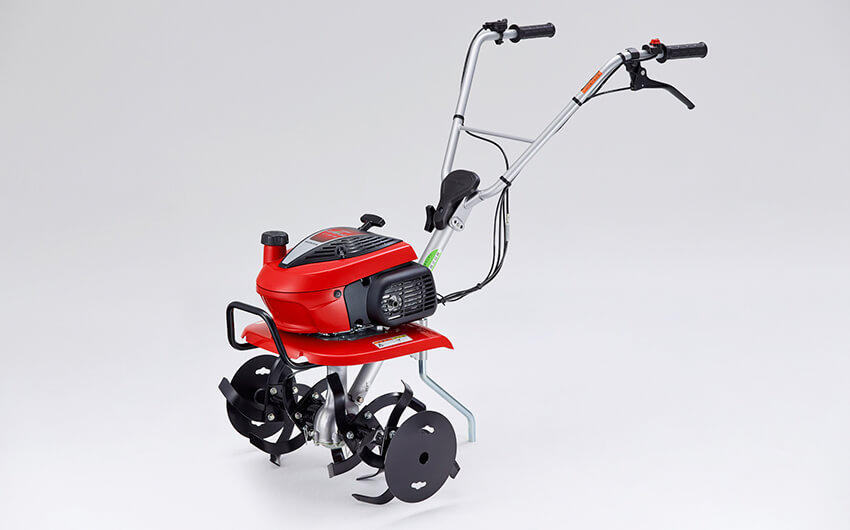
The Komame F200 garden tiller underwent repeated model changes, evolving into the 4th generation F220 in 2016.
TV commercials and other marketing campaigns expanded the Comame F200’s appeal, giving it a remarkable degree of popularity as a hobby model. Its reputation was further enhanced by demonstrations at an agricultural show in Paris, which helped it achieve record sales figures of over 40,000 units worldwide in only the first year following its debut.
The Mini Komame F110 was born as the result of requests for a smaller garden tiller, and was fully remodeled as the FS201 in 2002. In 2016, its entire design was changed.
The new demand for hobby-type tillers created by the Comame F200 forced other manufacturers to adopt the name ‘Comame’ for their own mini-tillers, making the name virtually synonymous with these useful devices. The third model change for this popular tiller was released as the Comame F220 in 2001, and was followed by the 4th generation F220 in 2016. Total sales worldwide reached 550,000 units (as of 2016), making it a remarkably long-term hit product.
The Salad FF300 offered excellent cultivating capability with easy operation.
As needs began to diversify in this newly-formed market for hobby-type farm and garden equipment, calls for lighter and more compact tillers at lower prices—and even higher-priced versions that were easier to operate—came to be heard. Responding to these requests, Honda released the Mini Comame F110 in 1993 as an even smaller model specially designed for first-time users. The Puchina FG201 was released in 2016 as a continuation of the line.
The Pianta FV200 was fueled by easy-to-use cassette-type LPG gas cartridges.
In 2003, Honda released the Salad FF300 with the Comame F220’s low center-of-gravity engine mounted in reverse and its tiller blades positioned in front instead of directly below to create a high-end model with superior straight-line stability. It was further equipped with Honda’s unique Active Rotary System (ARS), which rotates the inner tines of the front rotary in the normal direction while the outer tines rotate in reverse to better stabilize tilling operation at its set depth.
In 2009, the Pianta FV200 was released as a specially developed hobby model that offered a new focus on more convenient refueling and storage, as well as enhanced carrying ease.
The Pianta FV200 uses convenient and easy-to-buy LPG (liquid propane gas) canisters for fuel instead of conventional gasoline, making the tasks of refueling and fuel storage both safer and easier. The specified gas canister is inserted into a specially designed case for attachment or detachment from the machine with just a single action.
The FV200’s engine was based on the gasoline-type unit powering the Puchina FG201, and equipped with unique safety features such as a pressure-detection valve that shuts off when fuel line pressure rises too high, and a shut-off valve that automatically cuts the fuel supply when the engine stops. Other new functions like a vaporizer, which uses the heat from the exhaust to efficiently vaporize the fuel gas, took into consideration outside air temperatures at the time of year (early spring) that the tiller was most likely to be used (e.g. when sowing seeds).
The Puchina FV200 was also equipped with wheels to make it easier to maneuver by hand, and came with its own stand and carrying crate for placing it in the trunk of a car or storing it indoors. These features helped achieve the easy fueling, easy movement and easy storage required of a home and hobby model.
The Pianta FV200 succeeded in stimulating even greater demand for Honda tillers, as ninety percent of its purchasers were first-time buyers.
Honda’s tillers work with nature to cultivate the soil, and of course do so well within the world’s strictest regulations governing exhaust emissions and noise for both Europe and the USA. They also maintain excellent environmental performance with the best fuel economy figures in their class.
Starting from the original F150, which had such a profound effect in revolutionizing farm work and lightening the heavy burden of farmers throughout Japan, Honda’s tillers have evolved to meet the demands of farmers everywhere, and have been a driving force in their widespread adoption. Also, as farming in Japan has changed with the times, Honda has likewise successfully adapted by developing and manufacturing super-compact hobby-type tillers, a previously unseen but now significant part of the market. This development has subsequently allowed many more people to enjoy the pleasure of tilling the soil.
If there had been no F150, and if there had been no Comame… If Honda had not become a maker of agricultural
equipment, but remained an engine manufacturer, its flexible thinking and immense technological capabilities
would still surely have had a significant influence on the evolution of agriculture both in Japan and around the
world.
Snowthrowers
In Japan, a country that has half its territory regularly covered by heavy winter snows, the difficult work of clearing roads and pathways of snow had traditionally been done manually. Likewise, by the 1960s motorization had only just arrived in these snowy regions where horse-drawn sleds still provided much of the transport in winter, leading to the gradual introduction of powered snowplows to clear the main roads.
These large industrial machines were often noisy and difficult to operate, hence ordinary households still generally relied on manual shoveling to clear away the snow. However, Japan’s era of rapid economic growth saw a large migration of younger people gravitating toward the cities in search of jobs, further exacerbating the shortage of young men to clear snow in the off season. This left the backbreaking work of snow removal to the women, children and elderly who remained in the snowbound villages of the countryside.
In the United States, where virtually every home had at least one car, the use of compact snowthrowers for home use had already become widespread in snowy regions. In the mid-1970s, US snowthrowers began to be imported and sold in Japan, but though they could cope with light American snow, they were finding it difficult standing up to the wet and heavy snows of much of Japan.
By this time Honda was already building and selling a range of agricultural machinery and generators, advancing mechanization in order to lighten workloads. Seeing the importance of snowthrowers in helping to attain this goal, Honda began research and development of these machines in 1978.
But even within Japan the quality of snow differed from region to region, from the lighter and drier snows of Hokkaido to the wet and heavy snows found near the Sea of Japan. On top of this, snow could take many forms, from new fallen snow to compacted snow and snow that had fallen off roofs to powder snow. As part of its development of snowthrowers, Honda investigated all the different types of snow it could find, not just in Japan but also in Canada and even near the South Pole.
In 1980 Honda released its first compact snowthrower, the HS35 Snowler. This snowthrower operated by drawing in snow with a circular blade called an ‘auger’ and throwing it out of a discharge chute via an impeller called the ‘blower.’ The standard mechanism was generally of a rotary type, but Honda focused on the operating system and designed a much simpler set of controls. Once the user turned the engine on, all they had to do was grip a single clutch lever to make the machine draw in and throw out the snow, making it possible to remove as much as 30 tons of snow per hour. For safety, the auger and machine were both designed to stop moving if the user ever let go of the clutch lever. The HS35 Snowler’s folding handlebar also made it easier to store the snowthrower during the months when not in use, and its relative light weight of just 45kg further reduced workloads during the winter season.
Honda’s next challenge was to develop a snowthrower that would be able to work even more efficiently over wider areas. However, removing large volumes of snow required a lot more than mounting a big engine on a big chassis. For more efficient snow removal, Honda focused on the ability to adjust vehicle speed to match load requirements (or the amount of snow), and on where the snow would be discharged. Innovative techniques were continuously applied to simplify vehicle speed adjustment. And although a bigger auger could draw in larger amounts of snow, increasing the load, this would also greatly reduce engine speeds, sometimes causing it to either stop or ride up over uncleared snow. To avoid these situations, a way was needed to adjust vehicle speed while reducing the snow removal load in order to maintain higher engine speeds.
In 1984, the introduction of the HS70 Snowler solved these problems with a combination of 3 forward gears and 1 reverse gear. Its clutch design allowed users to easily shift between the 3 gears to adjust forward speed. The HS870S and HS660S Snowler models released in 1989 further introduced hydrostatic transmissions (HST) to allow users to adjust the machine’s speed continuously, forward and back, by way of a single lever, and without having to bother with a clutch.
The HS1390i Snowler-i, the world’s first hybrid snowthrower.
Then, in 2001, the mid-sized HS1390i Snowler took another step forward by employing the world’s first hybrid system designed for snowthrowers. This hybrid model only used the engine for the actual function of snow removal, while its two electric motors, installed on either side, provided the machine’s forward and backward motion. Continuously monitoring the load on the engine, the HS1390i’s main ECU (electronic control unit) also simultaneously controlled the track drive’s electric motors, automatically adjusting its speed accordingly. These electric motors also provided smoother motion and easier turning capability.
The mid-sized HSMI1590i introduced in 2005 was equipped with Honda’s next-generation iGX engine, which was the first to utilize a digital ECU (Electronic Control Unit) to control its operation. Using this ECU for both engine control and mutual communication with the ECU controlling the electric motors in the chassis, enabled smoother speed adjustments with no time lag.
A single dial allowed the user to easily select from three modes of operation: an Auto mode that automatically controlled both forward speed and engine rpms, a Power mode that maintained the engine at maximum output for jobs that required more power, and a Manual mode that provided conventional manual snowthrower operation. This ensured that virtually everyone from beginners to more experienced users could run the machine, whatever the task or one’s operating skill levels.
Over the years, Honda has also introduced an assortment of new technologies specifically for snowthrowers. As rotary-type snowthrowers tend to use nearly 70% of their engine output for the actual act of ‘throwing’ the snow from the blower, a critical element of operation was to allow the throwing distance and direction to be adjusted while aiming at a particular point, while also constantly checking for safety in the surrounding area. The 1984 HS70 Snowler used a two-stage system that separated the ‘auger’ from the ‘blower,’ thereby extending the throw range to up to 12 meters.
In 1989, the HS870S and HS660S adopted a single lever to allow rapid, high-accuracy positioning of the throwing direction and angle, for a fully remote-controlled snow chute. Combined with its novel square-shaped throwing outlet, this extended the throwing distance even further. Honda’s latest HSL2511, introduced in 2017, has even achieved a maximum throw range of up to 26 meters.
The automatic speed adjustment featured in Honda’s hybrid models synergistically enhances safety and efficiency to allow users to concentrate more on the actual function of throwing the snow. The engine’s ECU control helps maintain a constant engine speed for more consistent throwing distances. This means that users no longer have to continually adjust the throwing distance by hand, further making machine operation that much easier.
The HSS760nJX snowthrower utilized tiller technology to further enhance its snow-clearing capabilities.
Further, in 2013, Honda’s new HSS760nJX, HSS970nJX, and HSS1170nJX snowthrowers were the first in the world to incorporate Cross-Auger technology. A refinement initially developed for Honda’s ‘Salad’ lineup of front rotary tillers, the Cross-Auger features counter-rotating inner and outer rotary blades.
When working on highly compacted snow, or snow that has fallen from rooftops, conventional snowthrowers tend to rise up over the surface of the snow due to the reactive force of the auger. In such cases, ordinary augers can only gradually clear the snow by repeatedly being moved backwards and forwards over the surface. Conversely, the Cross-Auger’s dual clockwise and counter-clockwise auger rotation helps to limit this reactive force to prevent the snowthrower from riding up onto the snow, thus enabling it to clear away even hard-packed snow with a consistent motion.
In 1995, Honda added the HS2512Z Snowfighter, a large-capacity snowthrower that offered top-level snow removing capabilities, to its snowthrower lineup.
Then, in 2013, Honda released it latest model, the HSL2511, which incorporated the Auger-Lift function featured on the mid-sized 2005 HSM1590i. This function automatically lifts the auger when the drive lever is put into reverse, then returns it to the same operating height when returned to forward drive again. It also features an Auger Reset button that enables the auger position to be returned to a preset position or placed in an absolute horizontal position at the touch of a button.
Further, its Auger Assist function automatically compensates for any tilting of the snowthrower by moving the Auger in whatever direction necessary to maintain an even level for snow removal. Together, these three functions combined to create the world’s first Smart Auger System. This HSL2511 was also the world’s first gasoline-powered snowthrower to adopt a computer-controlled fuel injection system for easier starting and low fuel consumption even in freezing temperatures.
For small amounts of snow, or locations where a snowthrower can’t be used, Honda’s lineup has been further enhanced by addition of two more models. The Yukios SB800 is a compact and easy-to-use blade-type snowplow that can push snow to a more out-of-the-way location. The Yukios-e is another compact blade-type snowplow, but with an electric drive system that can be charged from any home electrical socket. It’s operation is also extremely quiet, making it perfect for early morning or late night use.
Honda’s snowthrowers have continually reflected user preferences and requests, innovatively putting technology to use to simplify difficult jobs. Honda’s complete lineup of red snowthrowers all share the same quiet operation, safety, durability, and superior environmental performance of other Honda Power Products, and consistently maintain a top share in both Japan and world markets.
The electrically-powered Yukios-e snowthrower can be easily charged from a standard home electrical socket.
Handheld Power Tools
Handheld power tools like trimmers, chainsaws, blowers, and sprayers are used all over the world. The term ‘handheld power tools’ is generally used to describe tools that are equipped with motors or engines to give support to human power. The global market for these tools exceeds 40 million units annually (2013 figures), of which 47% are cutters (such as lawnmowers).
The most important factors determining the engines used in these handheld devices, regardless of whether they’re for commercial or home use, is their size and weight, so they need to be as compact and lightweight as possible.
Released in 1953, Honda’s first general-purpose engine was the H-type, a 2-stroke engine developed specifically to power a backpack sprayer, a device that falls into the handheld power tools category. The H-type’s development emphasized a compact, lightweight design in order to lighten the burden for the worker. Its use of aluminum die-cast parts was ground-breaking at the time, and made the H-type a pioneering example of a lightweight handheld engine.
On the other hand, the 4-stroke T-type general-purpose engine Honda released the following year was designed for rugged durability and better fuel economy to power farm machinery, rather than as an engine to be used with handheld devices.
Generally speaking, the engines used for handheld power tools have primarily been 2-stroke models, as their simpler designs and smaller number of parts make them lighter and more compact. Also, due to their unique fuel mixture of gasoline and oil, 2-stroke engines don’t require separate lubrication systems, making it possible for them to be used while tilted at different angles, perfectly fitting the needs of handheld power tools. This fuel mixture of gasoline and oil also provides ample lubrication to the 2-stroke engine so that it can continue to operate unimpaired at whatever angle it’s held.
4-stroke engines, on the other hand, have always been designed to be lubricated by a separate reservoir of engine oil that has usually been held in the crankcase sump, which means they could often seize if tilted beyond a 30° angle. These engines also have relatively complex and heavy geartrains to operate their valves, so the general consensus for years was that 4-stroke engines were not suitable for use with handheld power tools.
Clearly, 2-stroke engine won out for their lightness and usability, but they still had much need for improvement: notably in regards to their poor fuel economy, excessive noise and vibration, and in particular their smelly gas fumes, which were usually accompanied by billowing plumes of white smoke. Also, in 1996, the California Air Resources Board (CARB) released its Small Off-Road Engine (SORE) exhaust emissions regulations, which required that a catalyzer or similar air purification device be attached to 2-stroke engines, due to their excessive exhaust gas emissions.
The enactment of these exhaust emissions regulations spurred Honda to specially develop a 4-stroke engine to be used with handheld power tools that could help people and the world, as well as the future with its technology. The result was the M4-1 engine (meaning the first Mini 4-stroke engine) designed to offer the same usability as a 2-stroke.
Honda technology resulted in a super-compact 4-stroke engine.
Honda overcame the challenge of lightening the 4-stroke engine by developing an overhead valve (OHV) configuration that utilized a single plastic cam to downsize and lighten the valvetrain. It also adopted a lightweight high-silicon aluminum Uniblock cylinder with a sleeveless design that eliminated the usual heavy iron cylinder sleeve. The engine’s 3.3kg dry weight helped it achieve compactness on the level of a 2-stroke engine.
The biggest problem in the design of this new 4-stroke engine was lubrication, which was successfully solved with the development of a new technology called the ‘Rotary Slinger Pumping Lubrication System.’ The design uses a dry sump lubrication system that separates the oil reservoir from the crankcase to prevent oil from entering the combustion chamber, whatever angle the engine is tilted.
The piston’s reciprocating motion generates pressure pulses inside the engine’s crankcase that work like a pump to draw oil in from the external oil tank through suction ports in the crankcase. Impellers attached to the crankshaft then splash the engine oil around inside the engine to provide needed lubrication. This new technology made possible—for the first time ever—a 4-stroke engine that can be rotated 360° with no ill effects.
The new engine cleared US Federal EPA and CARB exhaust emissions regulations with ease, and without need for any ancillary post-processing devices like catalyzers. Together with its incredible fuel economy, the M4-1’s superb environmental performance gave testament to the technological advancement of Honda engines.
The M4-1 engine was released in 1997 as the GX22 (22.2cc; 1PS/7000rpm) and the GX31 (31cc; 1.5PS/7000rpm). These
engines were used in various Honda Handheld power tools, like the UMK422 & UMK431 Karimaru 4 trimmers and
brush cutters, and the WJR2210, 2215 and 2225 backpack-style power sprayers.
From the beginning, Honda has also paid close attention to the safety of the users of its handheld power tools, supplying items like safety glasses (or goggles), which are needed when using such equipment as trimmers, as standard accessories. The inclusion of safety goggles later became a standard feature for trimmers throughout the industry, but Honda actively focused on the safety of these devices from its very first models.
The GX25 achieved its remarkably small size and light weight due to features like its OHC configuration.
Honda’s first generation of 4-stroke handheld engines, the GX22 and GX31, were also supplied as OEM engines to numerous manufacturers of handheld power equipment, and went on to become record-breaking hit products with total sales of over 1.2 million units.
Several years after the release of the M4-1 engine, Honda began work on the M4-0, aiming to further increase its power and lower its weight in response to user requests. Repositioning the oil chamber and valve chamber, essential to a 4-stroke engine, in a centralized layout was also key to achieving the engine’s smaller size and lighter weight. Honda’s unique overhead camshaft (OHC) design, featuring a newly developed ‘world’s smallest timing belt,’ was further added to create a unique framework. Engine displacement was also increased (from 22.2cc to 25cc) to improve the power-to-weight ratio by 30% (relative to the M4-1), and succeeded in greatly enhancing the new engine’s appeal.
On top of this, the new model achieved the highest ratings in the United States Environmental Protection Agency’s (EPA) Phase 2 Small Nonroad Spark-Ignition (NSRI) Engines exhaust emissions regulations, said to be the strictest in the world. This superb environmental performance was further demonstrated by clearing the EC Directive’s Stage 2 Non-Road Mobile Machinery (NRMM) exhaust emissions regulations (implemented in 2007) way ahead of schedule, and the Japan Land Engine Manufacturers Association (LEMA; 2011) Stage 2 voluntary emission regulations.
The M4-0 engine was released in 2002 as the GX25 (25cc; 0.81kW [1.1PS]/7,000rpm). The following year (2003) saw
the release of the higher-output GX35 (35cc, 1.2kW [1.6PS]/7,000rpm), both of which were used in various existing
trimmer and sprayer models, as well as other power products like Honda’s new Handy Blower HHB25 (released in
Japan in 2016).
Sales of the M4-0 engine also expanded into the OEM market supplying other manufacturers. In addition to handheld power tools, this engine also found a wide range of applications, from household devices like compact tillers and water pumps to commercial devices like rammers. As of 2017, it’s been nearly 15 years since the GX25 and GX35 first debuted, yet these long-selling products continue to record over 700,000 units in sales each and every year.
As exemplified by Honda’s F150 Tiller, E300 Generator, and HR21 Lawnmower, the key to becoming the best seller in
any category is product development aimed not merely at the present, but also with a steady eye on conditions
that may arise more than a decade into the future. As the world’s lightest 4-stroke engines, the GX25 and GX35
clearly embody Honda’s vision for the future.
